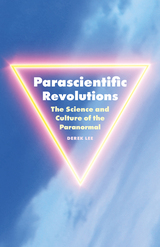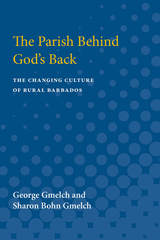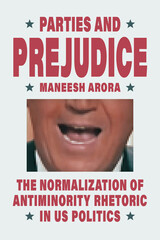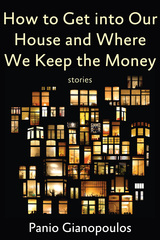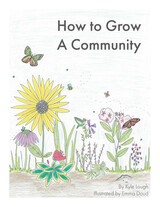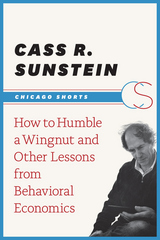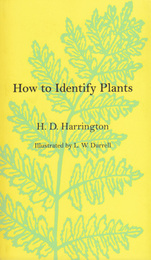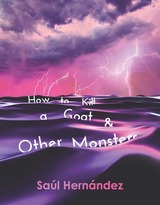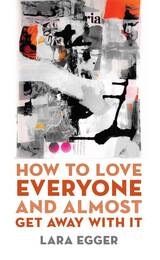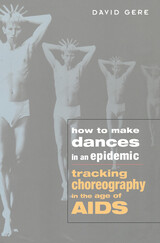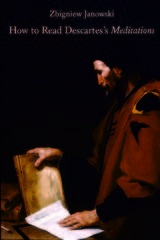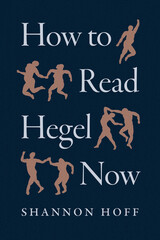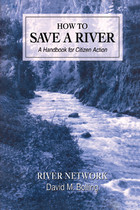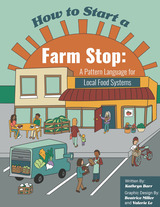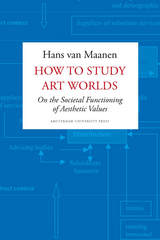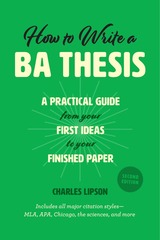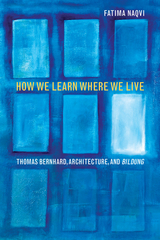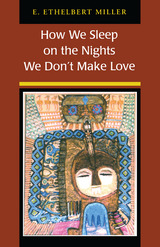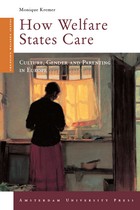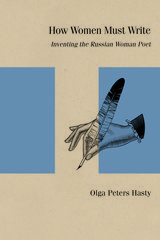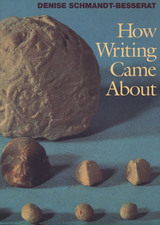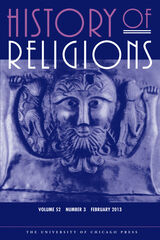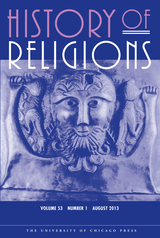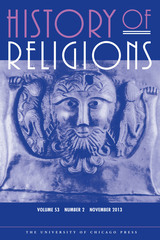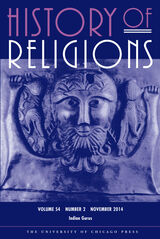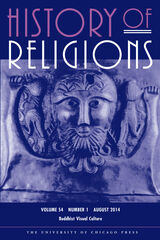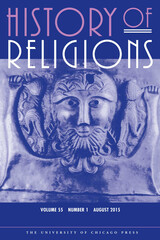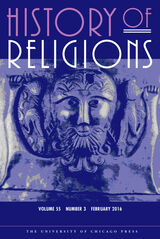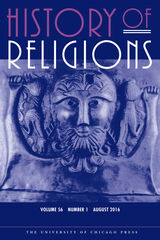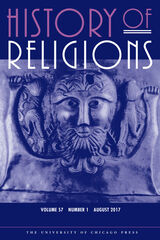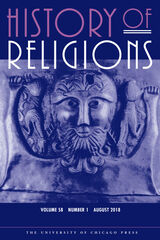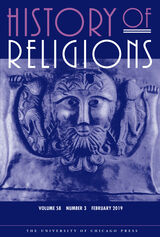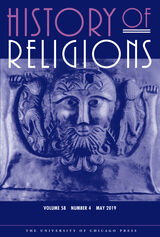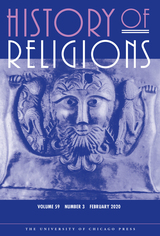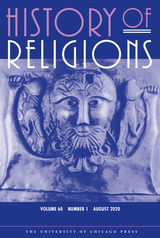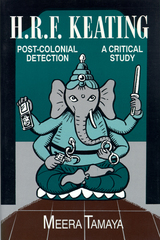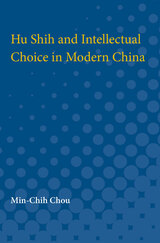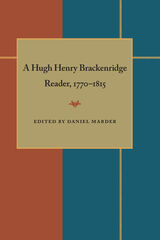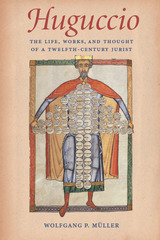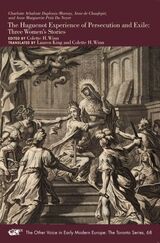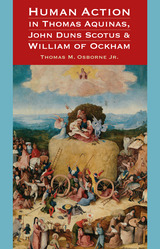How to Get into Our House and Where We Keep the Money
Panio Gianopoulos
Four Way Books, 2017 In a bizarre love triangle, a man becomes increasingly desperate for the attention of a woman obsessed with her little dog. A hapless unromantic develops an algorithm to help him succeed at dating. And a divorcee becomes consumed with jealousy when a man she likes begins to date her 60 year old mother. In these tales of love pursued, yet rarely caught, characters find themselves tripping, sometimes painfully, sometimes hilariously, toward self-revelation. Here is life in all of its clumsiness, humor, and beauty.
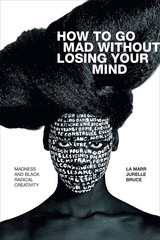 How to Go Mad without Losing Your Mind: Madness and Black Radical Creativity
La Marr Jurelle Bruce
Duke University Press, 2020 “Hold tight. The way to go mad without losing your mind is sometimes unruly.” So begins La Marr Jurelle Bruce's urgent provocation and poignant meditation on madness in black radical art. Bruce theorizes four overlapping meanings of madness: the lived experience of an unruly mind, the psychiatric category of serious mental illness, the emotional state also known as “rage,” and any drastic deviation from psychosocial norms. With care and verve, he explores the mad in the literature of Amiri Baraka, Gayl Jones, and Ntozake Shange; in the jazz repertoires of Buddy Bolden, Sun Ra, and Charles Mingus; in the comedic performances of Richard Pryor and Dave Chappelle; in the protest music of Nina Simone, Lauryn Hill, and Kendrick Lamar, and beyond. These artists activate madness as content, form, aesthetic, strategy, philosophy, and energy in an enduring black radical tradition. Joining this tradition, Bruce mobilizes a set of interpretive practices, affective dispositions, political principles, and existential orientations that he calls “mad methodology.” Ultimately, How to Go Mad without Losing Your Mind is both a study and an act of critical, ethical, radical madness.
How to Grow a Community
Kyle Lough
Michigan Publishing, 2023 This book was created for the course titled “Nature, Culture, & Landscape” taught by Professor Sara Adlerstein-Gonzalez at the University of Michigan School for Environment & Sustainability.
The objective was to create a book that uses the topic of urban gardening to teach young readers about the importance of environmental stewardship— respecting and caring for Earth and the diversity of life it sustains.
Through art and science, we can better understand complex environmental issues like access to food and water, loss of biodiversity, and land-use. Any reader, of any age, can make a difference in their community through forming stronger connections with people and the earth.
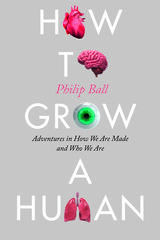 How to Grow a Human: Adventures in How We Are Made and Who We Are
Philip Ball
University of Chicago Press, 2019 Two summers ago, scientists removed a tiny piece of flesh from Philip Ball’s arm and turned it into a rudimentary “mini-brain.” The skin cells, removed from his body, did not die but were instead transformed into nerve cells that independently arranged themselves into a dense network and communicated with each other, exchanging the raw signals of thought. This was life—but whose?
In his most mind-bending book yet, Ball makes that disconcerting question the focus of a tour through what scientists can now do in cell biology and tissue culture. He shows how these technologies could lead to tailor-made replacement organs for when ours fail, to new medical advances for repairing damage and assisting conception, and to new ways of “growing a human.” For example, it might prove possible to turn skin cells not into neurons but into eggs and sperm, or even to turn oneself into the constituent cells of embryos. Such methods would also create new options for gene editing, with all the attendant moral dilemmas. Ball argues that such advances can therefore never be about “just the science,” because they come already surrounded by a host of social narratives, preconceptions, and prejudices. But beyond even that, these developments raise questions about identity and self, birth and death, and force us to ask how mutable the human body really is—and what forms it might take in years to come.
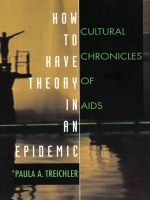 How to Have Theory in an Epidemic: Cultural Chronicles of AIDS
Paula A. Treichler
Duke University Press, 1999 Paula A. Treichler has become a singularly important voice among the significant theorists on the AIDS crisis. Dissecting the cultural politics surrounding representations of HIV and AIDS, her work has altered the field of cultural studies by establishing medicine as a legitimate focus for cultural analysis. How to Have Theory in an Epidemic is a comprehensive collection of Treichler’s related writings, including revised and updated essays from the 1980s and 1990s that present a sustained argument about the AIDS epidemic from a uniquely knowledgeable and interdisciplinary standpoint. “AIDS is more than an epidemic disease,” Treichler writes, “it is an epidemic of meanings.” Exploring how such meanings originate, proliferate, and take hold, her essays investigate how certain interpretations of the epidemic dominate while others are obscured. They also suggest ways to understand and choose between overlapping or competing discourses. In her coverage of roughly fifteen years of the AIDS epidemic, Treichler addresses a range of key issues, from biomedical discourse and theories of pathogenesis to the mainstream media’s depictions of the crisis in both developed and developing countries. She also examines representations of women and AIDS, treatment issues, and the role of activism in shaping the politics of the epidemic. Linking the AIDS tragedy to a uniquely broad spectrum of contemporary theory and culture, this collection concludes with an essay on the continued importance of theoretical thought for untangling the sociocultural phenomena of AIDS—and for tackling the disease itself. With an exhaustive bibliography of critical and theoretical writings on HIV and AIDS, this long-awaited volume will be essential to all those invested in studying the course of AIDS, its devastating medical effects, and its massive impact on contemporary culture. It should become a standard text in university courses dealing with AIDS in biomedicine, sociology, anthropology, gay and lesbian studies, women’s studies, and cultural and media studies.
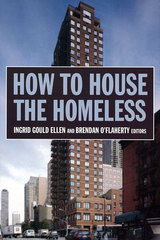 How to House the Homeless
Ingrid Gould Ellen
Russell Sage Foundation, 2010 How to House the Homeless, editors Ingrid Gould Ellen and Brendan O'Flaherty propose that the answers entail rethinking how housing markets operate and developing more efficient interventions in existing service programs. The book critically reassesses where we are now, analyzes the most promising policies and programs going forward, and offers a new agenda for future research. How to House the Homeless makes clear the inextricable link between homelessness and housing policy. Contributor Jill Khadduri reviews the current residential services system and housing subsidy programs. For the chronically homeless, she argues, a combination of assisted housing approaches can reach the greatest number of people and, specifically, an expanded Housing Choice Voucher system structured by location, income, and housing type can more efficiently reach people at-risk of becoming homeless and reduce time spent homeless. Robert Rosenheck examines the options available to homeless people with mental health problems and reviews the cost-effectiveness of five service models: system integration, supported housing, clinical case management, benefits outreach, and supported employment. He finds that only programs that subsidize housing make a noticeable dent in homelessness, and that no one program shows significant benefits in multiple domains of life. Contributor Sam Tsemberis assesses the development and cost-effectiveness of the Housing First program, which serves mentally ill homeless people in more than four hundred cities. He asserts that the program's high housing retention rate and general effectiveness make it a viable candidate for replication across the country. Steven Raphael makes the case for a strong link between homelessness and local housing market regulations—which affect housing affordability—and shows that the problem is more prevalent in markets with stricter zoning laws. Finally, Brendan O'Flaherty bridges the theoretical gap between the worlds of public health and housing research, evaluating the pros and cons of subsidized housing programs and the economics at work in the rental housing market and home ownership. Ultimately, he suggests, the most viable strategies will serve as safety nets—"social insurance"—to reach people who are homeless now and to prevent homelessness in the future. It is crucial that the links between effective policy and the whole cycle of homelessness—life conditions, service systems, and housing markets—be made clear now. With a keen eye on the big picture of housing policy, How to House the Homeless shows what works and what doesn't in reducing the numbers of homeless and reaching those most at risk.
How to Humble a Wingnut and Other Lessons from Behavioral Economics
Cass R. Sunstein
University of Chicago Press, 2013 In How to Humble a Wingnut, leading constitutional scholar, behavioral economist, and former Administrator of the White House Office of Information and Regulatory Affairs Cass R. Sunstein examines the unconventional impetuses behind human decision-making. Why it is that people often choose to behave so strangely? Sunstein’s incisive commentaries point to recent empirical findings to demonstrate how and why people convince themselves they are right despite evidence to the contrary; fear dangers they are unlikely to encounter; and ignore real risks. Mining developments in recent behavioral studies for tips on everything from holiday shopping and political biases to staying healthy and clear thinking in general, Sunstein nudges his reader towards that rarest of grounds—understanding.
How to Identify Grasses and Grasslike Plants: Sedges and Rushes
H. D. Harrington
Ohio University Press, 1977 There is no easy way to identify grasses. And no one understands this better than H.D. Harrington, who observed thousands of students struggle and learn. His clear, concise, and well-organized guide will continue to be a basic and essential text for use in the classroom or in the field. The book contains over 500 drawings and an illustrated glossary.
How To Identify Plants
H. D. Harrington
Ohio University Press, 1957 First issued in 1957 by Swallow Press, this classic guide to the art of plant identification is now familiar to an entire generation of students. Harrington who was Professor of Botany and Curator of the Herbarium at Colorado State University, gives step-by-step instructions and definitions to help readers recognize and classify plants. The new printing has been reset and reformatted, and L.W. Durrell’s drawings and glossary—more than 500 images—have been digitally enhanced for clarity.
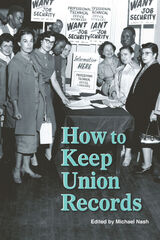 How to Keep Union Records
Michael Nash
Society of American Archivists, 2010 Ten chapters address issues of perennial concern to labor archivists: building relationships with the unions, developing collecting policies that support current labor history scholarship, adapting appraisal theory to the unique challenges of labor union archives, and arranging and describing collections so that finding aids speak to both academic and union audiences.
In the tradition of Debra E. Barnhardt's classic text on the subject, this new volume highlights recent transformations in the labor archives world, such as changes in recordkeeping practices, the imapct of union mergers and the consolidation movement on archival collections, the growing importance of media collections, and electronic records and union websites. Also included in the volume are an extensive bibliography and a directory of labor archives in the United States.
How to Keep Union Records illustrates how basic archival theory and best practice methodologies can be applied to the challenges presented by labor collections. Archivists in collecting repositories and union records administrators will greatly benefit from this excellent collection of essays by leaders in the field.
How to Kill a Goat and Other Monsters
Saúl Hernández
University of Wisconsin Press, 2024 One is never sure who the monsters are in these poems, only that the narrator desperately doesn’t want to be one. In his brilliant debut collection, Hernández explores grief, loss, identity, lineage, and belonging with grace, insight, and compassion.
These pages are infused with comfort, with desire, with heartache. Never absent is love, family. Hernández—hyperaware of American society’s dismissal or hatred of people who look like him—writes with a refreshing confidence, a sure knowledge of who he is and where he comes from. Transcending any particular experience, this volume will continue to resonate with multiple readings.
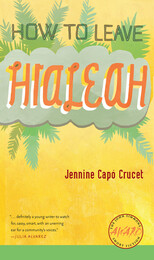 How to Leave Hialeah
Capó Crucet, Jennine
University of Iowa Press, 2009 United in their fierce sense of place and infused with the fading echoes of a lost homeland, the stories in Jennine Capó Crucet’s striking debut collection do for Miami what Edward P. Jones does for Washington, D.C., and what James Joyce did for Dublin: they expand our ideas and our expectations of the city by exposing its tough but vulnerable underbelly.
Crucet’s writing has been shaped by the people and landscapes of South Florida and by the stories of Cuba told by her parents and abuelos. Her own stories are informed by her experiences as a Cuban American woman living within and without her community, ready to leave and ready to return, “ready to mourn everything.”
Coming to us from the predominantly Hispanic working-class neighborhoods of Hialeah, the voices of this steamy section of Miami shout out to us from rowdy all-night funerals and kitchens full of plátanos and croquetas and lechón ribs, from domino tables and cigar factories, glitter-purple Buicks and handed-down Mom Rides, private homes of santeras and fights on front lawns. Calling to us from crowded expressways and canals underneath abandoned overpasses shading a city’s secrets, these voices are the heart of Miami, and in this award-winning collection Jennine Capó Crucet makes them sing.
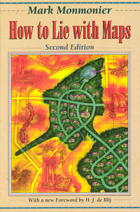 How to Lie with Maps
Mark Monmonier
University of Chicago Press, 1996 Originally published to wide acclaim, this lively, cleverly illustrated essay on the use and abuse of maps teaches us how to evaluate maps critically and promotes a healthy skepticism about these easy-to-manipulate models of reality. Monmonier shows that, despite their immense value, maps lie. In fact, they must.
The second edition is updated with the addition of two new chapters, 10 color plates, and a new foreword by renowned geographer H. J. de Blij. One new chapter examines the role of national interest and cultural values in national mapping organizations, including the United States Geological Survey, while the other explores the new breed of multimedia, computer-based maps.
To show how maps distort, Monmonier introduces basic principles of mapmaking, gives entertaining examples of the misuse of maps in situations from zoning disputes to census reports, and covers all the typical kinds of distortions from deliberate oversimplifications to the misleading use of color.
"Professor Monmonier himself knows how to gain our attention; it is not in fact the lies in maps but their truth, if always approximate and incomplete, that he wants us to admire and use, even to draw for ourselves on the facile screen. His is an artful and funny book, which like any good map, packs plenty in little space."—Scientific American
"A useful guide to a subject most people probably take too much for granted. It shows how map makers translate abstract data into eye-catching cartograms, as they are called. It combats cartographic illiteracy. It fights cartophobia. It may even teach you to find your way. For that alone, it seems worthwhile."—Christopher Lehmann-Haupt, The New York Times
". . . witty examination of how and why maps lie. [The book] conveys an important message about how statistics of any kind can be manipulated. But it also communicates much of the challenge, aesthetic appeal, and sheer fun of maps. Even those who hated geography in grammar school might well find a new enthusiasm for the subject after reading Monmonier's lively and surprising book."—Wilson Library Bulletin
"A reading of this book will leave you much better defended against cheap atlases, shoddy journalism, unscrupulous advertisers, predatory special-interest groups, and others who may use or abuse maps at your expense."—John Van Pelt, Christian Science Monitor
"Monmonier meets his goal admirably. . . . [His] book should be put on every map user's 'must read' list. It is informative and readable . . . a big step forward in helping us to understand how maps can mislead their readers."—Jeffrey S. Murray, Canadian Geographic
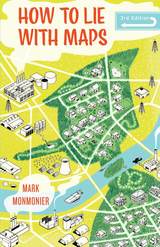 How to Lie with Maps, Third Edition
Mark Monmonier
University of Chicago Press, 2018 An instant classic when first published in 1991, How to Lie with Maps revealed how the choices mapmakers make—consciously or unconsciously—mean that every map inevitably presents only one of many possible stories about the places it depicts. The principles Mark Monmonier outlined back then remain true today, despite significant technological changes in the making and use of maps. The introduction and spread of digital maps and mapping software, however, have added new wrinkles to the ever-evolving landscape of modern mapmaking.
Fully updated for the digital age, this new edition of How to Lie with Maps examines the myriad ways that technology offers new opportunities for cartographic mischief, deception, and propaganda. While retaining the same brevity, range, and humor as its predecessors, this third edition includes significant updates throughout as well as new chapters on image maps, prohibitive cartography, and online maps. It also includes an expanded section of color images and an updated list of sources for further reading.
How to Live: A memoir-in-essays
Kelle Groom
Tupelo Press, 2023 “At its simplest, this is the story of a restless search for a place to be– a way to live– after a series of devastating events. But there’s nothing simple about it. Kelle Groom has created a marvel: a haunted, haunting, beautifully sustained dream of a book.”
—Joan Wickersham
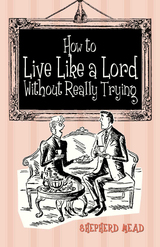 How to Live like a Lord Without Really Trying
Shepherd Mead
Bodleian Library Publishing, 2012 In 1958, ad man and soon-to-be best-selling author Shepherd Mead moved to England with his family to pursue his career. Six years later, his observations on the oddities of British culture were enough to compile a satirical guidebook for fellow Americans planning to visit from across the pond. The blunders that could befall them were many. For instance, explains Mead, “Pants are always underpants and what you wear out in the open are trousers. Mistakes in this area can lead to nasty misunderstandings.” Structured around the fictional Brash family—Peggy and Buckley Brash and their two children—the book, originally published in 1964, includes chapters on such topics as “How to Dress in England,” “The Dream House and How to Rebuild It,” and “How to Live with the Upper Classes Without Having Any Money.” Through the Brash family’s encounters with the British and their amusingly bewildered conversations as they attempt to interpret this alien way of life, Mead answers with obvious affection and quirky humor such questions as “Is England really a pest hole?” and “Do English schools create sex madness?” Written with Mead’s characteristic incisive wit and illustrated with the original dynamic cartoons, How to Live Like a Lord Without Really Trying is packed with pithy advice that is equally revealing of Britain in the 1960s as its bemused American visitors.
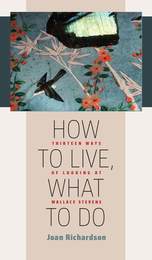 How to Live, What to Do: Thirteen Ways of Looking at Wallace Stevens
Joan Richardson
University of Iowa Press, 2018 How to Live, What to Do is an indispensable introduction to and guide through the work of a poet equal in power and sensibility to Shakespeare and Milton. Like them, Stevens shaped a new language, fashioning an instrument adequate to describing a completely changed environment of fact, extending perception through his poems to align what Emerson called our “axis of vision” with the universe as it came to be understood during his lifetime, 1879–1955, a span shared with Albert Einstein. Projecting his own imagination into spacetime as “a priest of the invisible,” persistently cultivating his cosmic consciousness through reading, keeping abreast of the latest discoveries of Einstein, Max Planck, Niels Bohr, Louis de Broglie, and others, Stevens pushed the boundaries of language into the exotic territories of relativity and quantum mechanics while at the same time honoring the continuing human need for belief in some larger order. His work records how to live, what to do in this strange new world of experience, seeing what was always seen but never seen before. Joan Richardson, author of the standard two-volume critical biography of Stevens and coeditor with Frank Kermode of the Library of America edition of the Collected Poetry and Prose, offers concise, lucid captures of Stevens’s development and achievement. Over the ten years of researching her Stevens biography, Richardson read all that he read, as well as his complete correspondence, journals, and notebooks. She weaves the details drawn from this deep involvement into the background of American cultural history of the period. This fabric is further enlivened by her preparation in philosophy and the sciences, creating in these thirteen panels a contemporary version of a medieval tapestry sequence, with Stevens in the place of the unicorn, as it were, holding our attention and eliciting, as necessary angel, individual solutions to the riddles of our existence on this planet spinning and hissing around its cooling star at 18.5 miles per second.
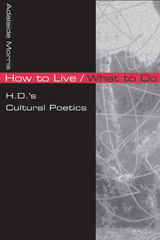 How to Live/What to Do: H.D.'s Cultural Poetics
Adalaide Morris
University of Illinois Press, 2002 The writing of H.D. is so linguistically rich and multilayered in structure that it has had almost as many interpretations as it has interpreters, from Freudians to feminists, from classicists to postmodernists. In How to Live/What to Do, however, Adalaide Morris removes the work of this iconic poet, dramatist, and novelist from compartments into which it has historically been placed. As she examines the "ongoingness" of H.D.'s writing, Morris makes an eloquent and compelling case for a consideration of poems--all poems--as forms of cultural mediation, instructive historical documents that engage the reader in wide-ranging contemporary debates and use their acoustical richness to generate tangible cultural effects. Ever since the publication of her first H.D. essay in 1985 (included here in an expanded version), Morris has eschewed prevailing literary trends in favor of new approaches that both challenge and overpass dominant critical constructs. As she argues in this volume, the writing and, crucially, the reading of poetry is a process in which meaning is produced by the interplay of words on a page and in the ear of the reader. This quality of being not heard but overheard, composed within the body, is crucial to an appreciation of H.D. Morris shows H.D. to be a playful linguistic innovator whose writings bear on debates in science, technology, and cinema as well as on poetry. Foremost, however, H.D. was a profound reshaper of the boundaries and possibilities of poetry, a generative form that, as this book shows, can indeed serve the cultural work of survival and resistance against the violence of modern culture.
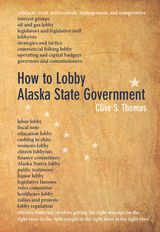 How to Lobby Alaska State Government
Clive S. Thomas
University of Alaska Press, 2019 Lobbying is about getting the right message to the right people in the right form at the right time. Even the most persuasive arguments or most influential groups will come up short if they aren’t combined with personal connections and an understanding of human nature. How to Lobby Alaska State Government is a guide to the essentials of organizing and implementing a lobbying campaign in Alaska that recognizes how you lobby is as important as who you lobby.
This book starts by helping new lobbyists to think politically, by explaining the structure and operation of state government, the psychology and needs of public officials, and where the power lies in Juneau—who’s got political clout. How to Lobby then moves into the nitty-gritty of a lobbying campaign. It covers the basics of group influence, campaign planning and management, the pros and cons of various group tactics, tips on face-to-face meetings, and the challenges of lobbying day-to-day. In addition to extensive guidance on what to do, this book also emphasizes the things to avoid that will undermine or eliminate a lobbyist’s chances of success. Pragmatic and portable, this book will be valuable to new and professional lobbyists both, and anyone looking for fresh perspectives on this important business.
How to Look Good in a War: Justifying and Challenging State Violence
Brian Rappert
Pluto Press, 2012 How to Look Good in A War examines the methods used to depict, defend and justify the use of state violence. Many books have shown how 'truth is the first casualty of war' but this is the first to analyse exactly how pro-war narratives are constructed and normalised.
Brian Rappert details the 'upside-down' world of war in which revelation conceals, knowledge fosters uncertainty, and transparency obscures. He looks at government spin during recent wars in Iraq, Afghanistan and Libya where officials manoeuvre between circulating and withholding information.
Examining how organised violence is justified, How to Look Good in A War draws on experiences from recent controversy to consider how ignorance about the operation of war is produced and how concerned individuals and groups can intervene to make a difference.
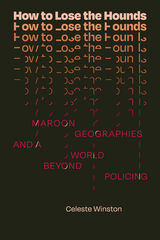 How to Lose the Hounds: Maroon Geographies and a World beyond Policing
Celeste Winston
Duke University Press, 2023 In How to Lose the Hounds Celeste Winston explores marronage—the practice of flight from and placemaking beyond slavery—as a guide to police abolition. She examines historically Black maroon communities in the Maryland suburbs of Washington, DC, that have been subjected to violent excesses of police power from slavery until the present day. Tracing the long and ongoing historical geography of Black freedom struggles in the face of anti-Black police violence in these communities, Winston shows how marronage provides critical lessons for reimagining public safety and community well-being. These freedom struggles take place in what Winston calls maroon geographies—sites of flight from slavery and the spaces of freedom produced in multigenerational Black communities. Maroon geographies constitute part of a Black placemaking tradition that asserts life-affirming forms of community. Winston contends that maroon geographies operate as a central method of Black flight, holding ground, and constructing places of freedom in ways that imagine and plan a world beyond policing.
How to Love Everyone and Almost Get Away with It
Lara Egger
University of Massachusetts Press, 2021 Winner of Ploughshares’ 2022 John C. Zacharis First Book Award
Wrestling with desire, shame, and the complications of attempting to resist one's own nature, How to Love Everyone and Almost Get Away with It offers a tragicomic tour of a heart in midlife crisis. Populated by unruly angels, earthbound astronauts, xylophones, wordplay, and glitter glue, these wildly associative poems transform the world line by line, image by image. Part confessional, part kitsch, and often self-deprecating, this debut collection offers an honest and tender exploration of love's necessary absurdity. Lara Egger asks: Who put the end in crescendo, the over in lover? Are metaphors always reliable witnesses? Why does the past sleep with us when we hope the person beside us is the future?
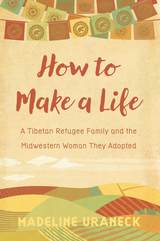 How to Make a Life: A Tibetan Refugee Family and the Midwestern Woman They Adopted
Madeline Uraneck
Wisconsin Historical Society Press, 2018 An immigration story of crossing cultural bridges and finding family.
When Madeline Uraneck said hello to the Tibetan woman cleaning her office cubicle, she never imagined the moment would change her life. After learning that Tenzin Kalsang had left her husband and four children behind in a Tibetan refugee settlement in India to try to forge a better life for them, Madeline took on the task of helping her apply for US visas. When the family reunited in their new Midwestern home, Madeline became swept up in their lives, from homework and soccer games to family dinners and shared holiday traditions. By reaching out, she found more than she bargained for—a family who welcomed her as their own and taught her more than she offered them.
An evocative blend of immersion journalism and memoir, How to Make a Life shares the immigration story of a Tibetan refugee family who crossed real and cultural bridges to make a life in Madison, Wisconsin, with the assistance of the Midwestern woman they befriended. From tales of escaping Tibet over the Himalayas, to striking a balance between old traditions with new, to bridging divides one friendly gesture at a time, readers will expand their understanding of family, culture, and belonging.
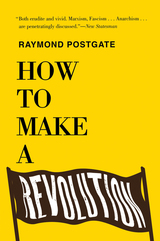 How to Make a Revolution
Raymond Postgate
Westholme Publishing, 2018 Written During the Ascension of Nazi Germany and Stalinist Russia, an investigation of the Methods of Revolutionary Change
The first third of the twentieth century saw a seismic upheaval in global politics and society that still reverberates today. Communism and fascism toppled both traditional monarchies and representative democracies, while trade unions and other factions effectively challenged existing governments to adopt reforms or face crippling economic or social upheaval. Given these extraordinary events, Raymond Postgate set forth in How to Make a Revolution to objectively discuss revolutionary methods, and which tactics or strategies are the most effective. Drawing on his own idealistic experience as a young labor agitator and editor of a communist newspaper and more than fifteen years of close study of past revolutionary history and theories, the author dispassionately discusses Marxism, fascism, anarchism, and Blanquism (a doctrine within socialism), as well as syndicalism and industrial unionism. He then reviews revolutionary practice, including general strikes, financial pressure, armed revolution, and communist tactics, and ends with a prescient and frightening conclusion: without general consensus and determination, a peaceful revolution is impossible, and “if no action is taken, action of another kind will be taken for us. . . . The continuance of uncertainty will mean that the disillusioned will drift steadily across to a Fascist organization. Fascism means war; the character of a Fascist State is fairly well known. Once it is established, those who read, who write, who publish or who print, books like this are likely to be dead or in concentration camps.” Originally published in 1934, Postgate’s book was heralded for its clarity and scholarship.
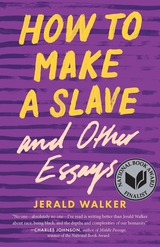 How to Make a Slave and Other Essays
Jerald Walker
Ohio State University Press, 2020 Finalist, National Book Award in Nonfiction
Winner, Massachusetts Book Award
A Book of the Year pick from Kirkus, BuzzFeed, and Literary Hub
“The essays in this collection are restless, brilliant and short.…The brevity suits not just Walker’s style but his worldview, too.…Keeping things quick gives him the freedom to move; he can alight on a truth without pinning it into place.” —Jennifer Szalai, the New York Times
For the black community, Jerald Walker asserts in How to Make a Slave, “anger is often a prelude to a joke, as there is broad understanding that the triumph over this destructive emotion lay in finding its punchline.” It is on the knife’s edge between fury and farce that the essays in this exquisite collection balance. Whether confronting the medical profession’s racial biases, considering the complicated legacy of Michael Jackson, paying homage to his writing mentor James Alan McPherson, or attempting to break free of personal and societal stereotypes, Walker elegantly blends personal revelation and cultural critique. The result is a bracing and often humorous examination by one of America’s most acclaimed essayists of what it is to grow, parent, write, and exist as a black American male. Walker refuses to lull his readers; instead his missives urge them to do better as they consider, through his eyes, how to be a good citizen, how to be a good father, how to live, and how to love.
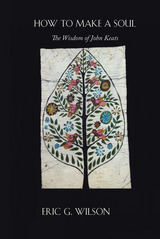 How to Make a Soul: The Wisdom of John Keats
Eric G. Wilson
Northwestern University Press, 2015 In this innovative hybrid of biography, memoir, and criticism, Eric G. Wilson describes how John Keats gave him solace during a bout of mental illness in spring 2012. While on a tour of the principal sites in Keats’s life—ranging from his London medical school to the small room in Rome where he died—Wilson discovered analogies between the poet’s troubles and his own. He was most struck by Keats’s enlivening vision of the soul. For Keats, we don’t possess but rather make a soul. We do this by imaginatively transforming our suffering into empathy toward humans and nature alike. Tracking this idea in Keats’s tumultuous yet exhilarating life and work, Wilson struggles to envision his depression anew, desperate to overcome the apathy alienating him from his family. How to Make a Soul offers fresh perspectives on Keats’s pragmatism, irony, comedy, ethics, and aesthetics, but is above all a lyrical celebration of those galvanizing instances when life springs into art.
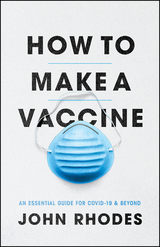 How to Make a Vaccine: An Essential Guide for COVID-19 and Beyond
John Rhodes
University of Chicago Press, 2021 Distinguished expert in vaccine development John Rhodes tells the story of the first approved COVID-19 vaccines and offers an essential, up-to-the-minute primer on how scientists discover, test, and distribute vaccines.
As the COVID-19 pandemic has affected every corner of the world, changing our relationship to our communities, to our jobs, and to each other, the most pressing question has been—when will it end? Researchers around the globe are urgently trying to answer this question by racing to test and distribute a vaccine that could end the greatest public health threat of our time. In How to Make a Vaccine, an expert who has firsthand experience developing vaccines tells an optimistic story of how three hundred years of vaccine discovery and a century and a half of immunology research have come together at this powerful moment—and will lead to multiple COVID-19 vaccines.
Dr. John Rhodes draws on his experience as an immunologist, including working alongside a young Anthony Fauci, to unravel the mystery of how vaccines are designed, tested, and produced at scale for global deployment. Concise and accessible, this book describes in everyday language how the immune system evolved to combat infection, how viruses responded by evolving ways to evade our defenses, and how vaccines do their work. That history, and the pace of current research developments, make Rhodes hopeful that multiple vaccines will protect us. Today the complex workings of the immune system are well understood. The tools needed by biomedical scientists stand ready to be used, and more than 160 vaccine candidates have already been produced. But defeating COVID-19 won’t be the end of the story: Rhodes describes how discoveries today are also empowering scientists to combat future threats to global health, including a recent breakthrough in the development of genetic vaccines, which have never before been used in humans.
As the world prepares for a vaccine, Rhodes offers a current and informative look at the science and strategies that deliver solutions to the crisis.
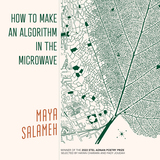 How to Make an Algorithm in the Microwave
Maya Salameh
University of Arkansas Press, 2022 Winner, 2022 Etel Adnan Poetry Prize “We need a new poetry lexicon—a new way of moleculing the poem on the page, even—and Maya Salameh brings it. We need all the strange Arabic-diasporic ways we can find for being in this terrible and joyful and often frighteningly banalizing world, and Salameh’s poems are a generous find. Her writing is an unexpected cousin in the colonized and capitalism-razed city, bewildering and divining things you’ve never heard but want to learn. . . . Prepare to be stretched and delighted.”
—Mohja Kahf, from the Foreword The divine and the digital achieve a distinct corporality in Maya Salameh’s HOW TO MAKE AN ALGORITHM IN THE MICROWAVE, winner of the 2022 Etel Adnan Poetry Prize. Layering prayer with code, Salameh brings supposedly unassailable technological constructs like algorithm, recursion, and loop into conversation with the technologies of womanhood, whether liner, lipstick, or blood. Exploring the relationships we have with our devices, she speaks back to the algorithm (“a computer’s admission to blood”), which acts simultaneously as warden, confidant, and data thief. Here Salameh boldly examines how an Arab woman survives the digitization of her body—experimenting with form to create an intimate collage of personal and neocolonial histories, fearlessly insinuating herself into the scripts that would otherwise erase her, and giving voice to the full mess of ritual.
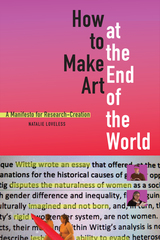 How to Make Art at the End of the World: A Manifesto for Research-Creation
Natalie Loveless
Duke University Press, 2019 In recent years, the rise of research-creation—a scholarly activity that considers art practices as research methods in their own right—has emerged from the organic convergences of the arts and interdisciplinary humanities, and it has been fostered by universities wishing to enhance their public profiles. In How to Make Art at the End of the World Natalie Loveless draws on diverse perspectives—from feminist science studies to psychoanalytic theory, as well as her own experience advising undergraduate and graduate students—to argue for research-creation as both a means to produce innovative scholarship and a way to transform pedagogy and research within the contemporary neoliberal university. Championing experimental, artistically driven methods of teaching, researching, and publication, research-creation works to render daily life in the academy more pedagogically, politically, and affectively sustainable, as well as more responsive to issues of social and ecological justice.
How to Make Dances in an Epidemic: Tracking Choreography in the Age of AIDS
David Gere
University of Wisconsin Press, 2004 David Gere, who came of age as a dance critic at the height of the AIDS epidemic, offers the first book to examine in depth the interplay of AIDS and choreography in the United States, specifically in relation to gay men. The time he writes about is one of extremes. A life-threatening medical syndrome is spreading, its transmission linked to sex. Blame is settling on gay men. What is possible in such a highly charged moment, when art and politics coincide?
Gere expands the definition of choreography to analyze not only theatrical dances but also the protests conceived by ACT-UP and the NAMES Project AIDS quilt. These exist on a continuum in which dance, protest, and wrenching emotional expression have become essentially indistinguishable. Gere offers a portrait of gay male choreographers struggling to cope with AIDS and its meanings.
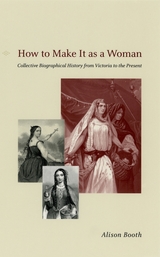 How to Make It as a Woman: Collective Biographical History from Victoria to the Present
Alison Booth
University of Chicago Press, 2004 How to Make It as a Woman outlines the history of prosopography or group biography, focusing on the all-female collections that took hold in nineteenth-century Britain and America. The queens, nurses, writers, reformers, adventurers, even assassins in these collective female biographies served as models to guide the moral development of young women. But often these famous historical women presented untrustworthy examples.
Beginning in the fifteenth century with Christine de Pizan, Alison Booth traces the long tradition of this genre, investigating the varied types and stories most often grouped together in illustrated books designed for entertainment and instruction. She claims that these group biographies have been instrumental in constructing modern subjectivities as well as relations among classes, races, and nations.
From Joan of Arc to Virginia Woolf, Booth examines a host of models of womanhood—both bad and good. Incorporating a bibliography that includes more than 900 all-female collections published in English between 1830 and 1940, Booth uses collective biographies to decode the varied advice on how to make it as a woman.
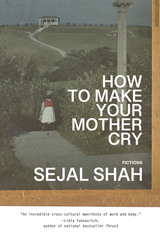 How to Make Your Mother Cry: Fictions
Sejal Shah
West Virginia University Press, 2024 2024/25 Story Prize Longlist 2024 Foreword Indies Finalist, Multicultural Adult Fiction
From the author of This Is One Way to Dance, linked genre-queer short stories braided with images and ephemera explore the experiences of growing up and living as a diasporic Gujarati woman searching for home. In the eleven linked short stories of How to Make Your Mother Cry, Sejal Shah builds a shrine gleaming with memory and myth. Keys, rocks, photographs, fairy tales, fables, and relics all add texture and meaning to an exploration of growing up and living as a diasporic Gujarati woman in a culture that excuses the behavior of men. Throughout, girls and women contend with the expectations, limitations, and challenges of becoming the heroine of one’s own life. How to Make Your Mother Cry—Shah’s follow-up to her award-winning essay collection This Is One Way to Dance—continues the rich tradition of innovative feminist work by Claudia Rankine, Leslie Marmon Silko, and Maxine Hong Kingston. By braiding stories and images with fictional letters to a beloved English teacher, the collection defies traditional autofiction, epistolary, and short story conventions. These astonishing stories about friendship and love, resilience and survival establish Shah as an exciting new voice in contemporary fiction.
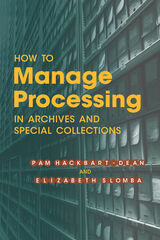 How to Manage Processing in Archives and Special Collections
Pam Hackbart-Dean
Society of American Archivists, 2012 Every archives strives to have an active, well-planned processing program, but achieving this is no easy task. How to Manage Processing in Archives and Special Collections breaks down what you need to know to establish or revitalize your processing program, delivering effective methods to help you succeed. This resource is packed with information about:
Creating a framework for a processing program, including developing processing policies, priorities, and strategies;
Managing the day-to-day work of processing assessment techniques;
Implementing best practices and standards;
Administering a patron-based approach to managing processing;
Effectively assessing the demands for descriptions and item-level cataloging to make collections available more swiftly; and
Applying standards in the adoption of trends and new concepts in processing and in handling outside demands.
Whether you manage numerous archivists, operate as one member of a processing team, or are a lone arranger, How to Manage Processing in Archives and Special Collections is your go-to guide for developing and managing a processing program. With an effective processing program in place, your archives will be better positioned to help users find the materials they need.
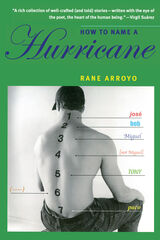 How to Name a Hurricane
Rane Arroyo
University of Arizona Press, 2005 There’s no denying it, media culture has ushered in a new era of visibility for gays in America. Yet somehow the gay Latino doesn’t fit into this sound-bite identity and usually isn’t included in national media images. Rane Arroyo offers a corrective. Known primarily as a poet and playwright representing the gay Latino community, Arroyo has also been publishing prose throughout his career and now gathers into this book a storm of writing that has been gaining strength, drop by drop, for more than ten years.
How to Name a Hurricane collects short stories and other fictions depicting Latino drag queens and leather men, religious sinners and happy atheists, working class heroes and cyberspace vaqueros—a parade of characters that invites readers to consider whether one is more authentic a gay Latino than another. Whereas actual hurricanes are given names, the gays given voice in this collection must name themselves—and these narratives in turn reveal something of the "I" of Hurricane Rane. Whether portraying a family gathering as Brideshead Revisited with a mambo soundtrack, recounting the relationship of transvestite Louie/Lois and her bisexual Superman, or bemoaning "feeling as unsexy as an old bean burrito in a 7-11 microwave," Arroyo tracks the heartbeat of his characters through a shimmering palette of styles. Here are monologues, a story in verse, and other experimental forms appropriate to experimental lives—all affirming the basic human rights to dignity, equality, love, and even silliness.
When the AIDS epidemic first hit, many Latino families destroyed any remembrances of their gay and bisexual sons that might betray their pasts to la familia or el pueblo. Arroyo’s writings return the ghosts of those sons to the families, bars, dance clubs, and neighborhoods where they belong. By penetrating to the I’s of narrative hurricanes, these stories honor the survivors of our ongoing cultural storms.
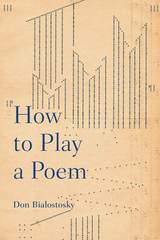 How to Play a Poem
Don Bialostosky
University of Pittsburgh Press, 2017 Approaching poems as utterances designed and packaged for pleasurable reanimation, How to Play a Poem leads readers through a course that uses our common experience of language to bring poems to life. It mobilizes the speech genres we acquire in our everyday exchanges to identify “signs of life” in poetic texts that can guide our co-creation of tone. How to Play a Poem draws on ideas from the Bakhtin School, usually associated with fiction rather than poetry, to construct a user-friendly practice of close reading as an alternative to the New Critical formalism that still shapes much of teaching and alienates many readers. It sets aside stock questions about connotation and symbolism to guide the playing out of dynamic relations among the human parties to poetic utterances, as we would play a dramatic script or musical score. How to Play a Poem addresses critics ready to abandon New Criticism, teachers eager to rethink poetry, readers eager to enjoy it, and students willing to give it a chance, inviting them to discover a lively and enlivening way to animate familiar and unfamiliar poems.
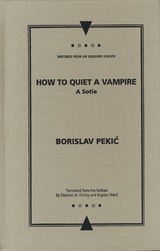 How to Quiet a Vampire: A Sotie
Borislav Pekic
Northwestern University Press, 2005 The disquieting novel How to Quiet a Vampire is a rumination on terror and intellect in the tradition of Joseph Heller and George Steiner. Published to acclaim in 1977, Pekic's novel of ideas follows Konrad Rutkowski, professor of medieval history and former Gestapo officer, as he returns to the scene of his war crimes determined to renounce, or perhaps justify, his Nazi past. In a series of letters, Rutkowski lays out his ambivalent reactions to war and violence, connecting his own swirling ideas to those of the major figures of European thought: Plato, St. Augustine, Descartes, Nietzsche, Freud, and others.
Delving far deeper than mere intellect, however, Borislav Pekic was himself a frequent political agitator and occasional prisoner, and he drew on his first hand knowledge of police methods and life under totalitarianism to paint a chilling portrait of a supposedly free-thinking intellectual acting in the service of repression. At the same time he questions whether Rutkowski's ideology puts him outside the philosophical tradition he so admires—or if the line separating European thought from totalitarianism is not as clear as we like to think.
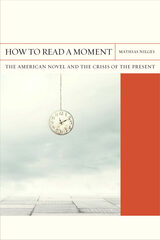 How to Read a Moment: The American Novel and the Crisis of the Present
Mathias Nilges
Northwestern University Press, 2021 In How to Read a Moment, Mathias Nilges shows that time is inseparable from the stories we tell about it, demonstrating that the contemporary American novel offers new ways to make sense of the temporality that governs our present.
“Time is a thing that grows scarcer every day,” observes one of Don DeLillo’s characters. “The future is gone,” The Baffler argues. “Where’s my hoverboard!?” a meme demands. Contemporary capitalism, a system that insists that everything happen at once, creates problems for social thought and narrative alike. After all, how does one tell the time of instantaneity? In this moment of on-demand service and instant trading, it has become difficult to imagine the future.
The novel emerged as the art form of a rapidly changing modern world, a way of telling time in its progress. Nilges argues that this historical mission is renewed today through works that understand contemporaneity as a form of time shaping that props up our material world and cultural imagination. But the contemporary American novel does not simply associate our present with a crisis of futurity. Through analyses of works by authors such as DeLillo, Jennifer Egan, Charles Yu, and Colson Whitehead, Nilges illustrates that the novel presents ways to make sense of the temporality that controls our purportedly fully contemporary world. In so doing, the novel recovers a sense of possibility and hope, forwarding a dazzling argument for its own importance today.
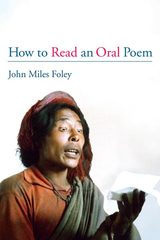 How to Read an Oral Poem
John Miles Foley
University of Illinois Press, 2002 Though they appear diverse, Homer's Odyssey and slam poetry from contemporary urban America both draw from the well of oral tradition. This unique, practical, and user-friendly guide explores the cultural contexts of verbal art to provide more-than-textual methods for understanding the structure, principles, and social applications of oral poetry.
Using dozens of examples, including a North American slam poet, a Tibetan paper-singer, a South African praise-poet, and an ancient Greek bard, John Miles Foley shows that although oral poetry long predates the invention of writing, it continues to be a vital culture-making and communications tool in societies all over the world. Based on fieldwork and archival research on epics, folktales, lyrics, laments, charms, and other oral traditions, How to Read an Oral Poem answers the questions, What is oral poetry? How does it work? What is reading, literally and figuratively?
This accessible and engaging work is enhanced by audio and video examples of oral poetry, which are available at http://www.oraltradition.org. The book can also be used as companion volume to Foley's Teaching Oral Traditions.
How to Read Barthes' Image-Music-Text
Ed White
Pluto Press, 2012 Roland Barthes remains one of the most influential cultural theorists of the postwar period and Image-Music-Text collects his most influential essays. Ed White provides students with a clear guide to this essential but difficult text.
As students are increasingly expected to write across a range of media, Barthes' work can be understood as an early mapping of what we now call interdisciplinary or multidisciplinary study. The book's detailed section-by-section readings makes Barthes' most important writings accessible to undergraduate readers.
This book is a perfect companion for teaching and learning Barthes' ideas in cultural studies and literary theory.
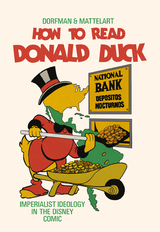 How to Read Donald Duck: Imperialist Ideology in the Disney Comic
Ariel Dorfman
Pluto Press, 2020 "The book has a rambunctious humor that complements its polemical spirit . . . As Disney has evolved from an animation studio into a corporate behemoth—with theme parks, a cruise line, and content streaming around the world—How to Read Donald Duck and its charge of cultural imperialism rings all the truer"—The New Yorker
First published in 1971, How to Read Donald Duck shocked readers by revealing how capitalist ideology operates in our most beloved cartoons. Having survived bonfires, impounding and being dumped into the ocean by the Chilean army, this controversial book is once again back on our shelves.
Written and published during the blossoming of Salvador Allende's revolutionary socialism in Chile, the book examines how Disney products reflect capitalist ideology, and are active agents working in this ideology’s favor. Focusing on the hapless mice and ducks of Disney, curiously parentless, marginalized and always short of cash, Ariel Dorfman and Armand Mattelart expose how these characters established hegemonic ideas about capital, race, gender and the relationship between developed countries and the Third World.
A devastating indictment of a media giant, a document of twentieth-century political upheaval, and a reminder of the dark undercurrent of pop culture, How to Read Donald Duck is once again available, together with a new introduction by Ariel Dorfman in which he writes.
"It is that joy in liberation, that alegria, that spirit of resistance, that I wish to share with America, as the book that Pinochet’s soldiers could not liquidate or Disney’s lawyers stop from entering the United States finally finds its way to its new home, deep into the land that invented Donald Duck and Donald Trump. Is the same country that gave me such a warm welcome as a child, and perhaps may now equally greet with open arms this critique of oppression and it certainty that we don’t have to leave the world as it was when we first encountered it."
How to Read Foucault's Discipline and Punish
Stephen Shapiro and Anne Schwan
Pluto Press, 2011 Michel Foucault’s Discipline and Punish is one of the best-selling works of critical theory and a key text on many undergraduate courses. However, it is a long, difficult text which makes Anne Schwan and Stephen Shapiro's excellent step-by-step reading guide a welcome addition to the How to Read Theory series.
Undergraduates across a wide range of disciplines are expected to have a solid understanding of Foucault's key terms, which have become commonplace in critical thinking today. While there are many texts that survey Foucault's thought, these are often more general overviews or biographical précis that give little in the way of robust explanation and discussion. In contrast, Schwan and Shapiro take a plain-speaking, yet detailed, approach, specifically designed to give students a thorough understanding of one of the most influential texts in contemporary cultural theory.
How to Read Hegel Now
Shannon Hoff
University of Chicago Press A powerful exploration of how Hegel’s ideas about freedom can speak to social injustice today.
One might be forgiven for feeling that the philosophical tradition, notoriously replete with seemingly aloof and problematic men like Hegel, has little to offer contemporary conversations about justice. Yet for Shannon Hoff, Hegel’s ideas about freedom in particular contain vital resources for efforts to redress racism, sexism, colonialism, ableism, and capitalism today.
In How to Read Hegel Now, Hoff rereads the German philosopher alongside our most compelling thinkers about how oppression disavows our common humanity, including Frantz Fanon, Jessica Benjamin, Saba Mahmood, la paperson, Jean-Paul Sartre, Georges Canguilhem, and Rosemarie Garland-Thomson. Along the way, Hoff recovers in Hegel a new vision for human freedom that challenges the heritage of modern liberalism he helped to construct.
How to Read Marx's Capital
Stephen Shapiro
Pluto Press, 2008 Das Capital Volume 1 is essential reading on many undergraduate courses, but the structure and style of the book can be confusing for students, leading them to abandon the text. This book is a clear guide to reading Marx's classic text, which explains the reasoning behind the book's structure and provides help with the more technical aspects that non-economists may find taxing.
Students are urged to think for themselves and engage with Marx's powerful methods of argument and explanation. Shapiro shows that Capital is key to understanding critical theory and cultural production.
This highly focused book will prove invaluable to students of politics, cultural studies, and literary theory.
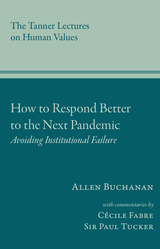 How to Respond Better to the Next Pandemic: Remedying Institutional Failures
Allen Buchanan, with contributions by Cécile Fabre and Sir Paul Tucker
University of Utah Press, 2024 There is no shortage of criticisms of U.S. COVID-19 policy. This book argues that officials at the highest levels lied to the public or deliberately suppressed relevant information, shamelessly over-sold the efficacy of masks and vaccines, and enacted lock-down policies of unproven value that caused massive economic, educational, and psycho-social damage.
In How to Respond Better to the Next Pandemic Allen Buchanan argues that, contrary to widespread opinion, the primary cause of flawed COVID-19 policy was not defective leadership, but rather institutional failure. Decisions were made through processes that lacked the most basic safeguards against the large-institution “yes-man” and group-think phenomena and included virtually no provisions for holding decision makers accountable. More fundamentally, policy makers did not fulfill the crucial duty to provide plausible public justifications for their decisions. They disguised the fact that scientific opinion was divided on the appropriateness of the policies they endorsed and labeled those who disagreed with them as anti-scientific. In some cases, they responded to criticism, not by engaging it on the issues, but by branding their critics as quacks.
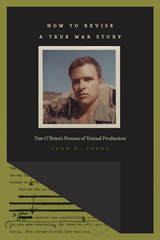 How to Revise a True War Story: Tim O'Brien's Process of Textual Production
John K. Young
University of Iowa Press, 2017 “You can tell a true war story if you just keep on telling it,” Tim O’Brien writes in The Things They Carried. Widely regarded as the most important novelist to come out of the American war in Viet Nam, O’Brien has kept on telling true war stories not only in narratives that cycle through multiple fictional and non-fictional versions of the war’s defining experiences, but also by rewriting those stories again and again. Key moments of revision extend from early drafts, to the initial appearance of selected chapters in magazines, across typescripts and page proofs for first editions, and through continuing post-publication variants in reprints.
How to Revise a True War Story is the first book-length study of O’Brien’s archival papers at the University of Texas’s Harry Ransom Center. Drawing on extensive study of drafts and other prepublication materials, as well as the multiple published versions of O’Brien’s works, John K. Young tells the untold stories behind the production of such key texts as Going After Cacciato, The Things They Carried, and In the Lake of the Woods. By reading not just the texts that have been published, but also the versions they could have been, Young demonstrates the important choices O’Brien and his editors have made about how to represent the traumas of the war in Viet Nam. The result is a series of texts that refuse to settle into a finished or stable form, just as the stories they present insist on being told and retold in new and changing ways. In their lack of textual stability, these variants across different versions enact for O’Brien’s readers the kinds of narrative volatility that is key to the American literature emerging from the war in Viet Nam. Perhaps in this case, you can tell a true war story if you just keep on revising it.
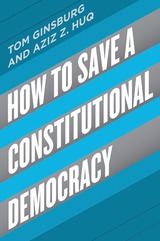 How to Save a Constitutional Democracy
Tom Ginsburg and Aziz Z. Huq
University of Chicago Press, 2018 Democracies are in danger. Around the world, a rising wave of populist leaders threatens to erode the core structures of democratic self-rule. In the United States, the tenure of Donald Trump has seemed decisive turning point for many. What kind of president intimidates jurors, calls the news media the “enemy of the American people,” and seeks foreign assistance investigating domestic political rivals? Whatever one thinks of President Trump, many think the Constitution will safeguard us from lasting damage. But is that assumption justified?
How to Save a Constitutional Democracy mounts an urgent argument that we can no longer afford to be complacent. Drawing on a rich array of other countries’ experiences with democratic backsliding, Tom Ginsburg and Aziz Z. Huq show how constitutional rules can both hinder and hasten the decline of democratic institutions. The checks and balances of the federal government, a robust civil society and media, and individual rights—such as those enshrined in the First Amendment—often fail as bulwarks against democratic decline. The sobering reality for the United States, Ginsburg and Huq contend, is that the Constitution’s design makes democratic erosion more, not less, likely. Its structural rigidity has had unforeseen consequence—leaving the presidency weakly regulated and empowering the Supreme Court conjure up doctrines that ultimately facilitate rather than inhibit rights violations. Even the bright spots in the Constitution—the First Amendment, for example—may have perverse consequences in the hands of a deft communicator who can degrade the public sphere by wielding hateful language banned in many other democracies. We—and the rest of the world—can do better. The authors conclude by laying out practical steps for how laws and constitutional design can play a more positive role in managing the risk of democratic decline.
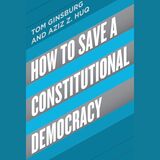 How to Save a Constitutional Democracy
Tom Ginsburg and Aziz Z. Huq
University of Chicago Press, 2018 This is an auto-narrated audiobook version of this book.
Democracies are in danger. Around the world, a rising wave of populist leaders threatens to erode the core structures of democratic self-rule. In the United States, the tenure of Donald Trump has seemed decisive turning point for many. What kind of president intimidates jurors, calls the news media the “enemy of the American people,” and seeks foreign assistance investigating domestic political rivals? Whatever one thinks of President Trump, many think the Constitution will safeguard us from lasting damage. But is that assumption justified?
How to Save a Constitutional Democracy mounts an urgent argument that we can no longer afford to be complacent. Drawing on a rich array of other countries’ experiences with democratic backsliding, Tom Ginsburg and Aziz Z. Huq show how constitutional rules can both hinder and hasten the decline of democratic institutions. The checks and balances of the federal government, a robust civil society and media, and individual rights—such as those enshrined in the First Amendment—often fail as bulwarks against democratic decline. The sobering reality for the United States, Ginsburg and Huq contend, is that the Constitution’s design makes democratic erosion more, not less, likely. Its structural rigidity has had unforeseen consequence—leaving the presidency weakly regulated and empowering the Supreme Court conjure up doctrines that ultimately facilitate rather than inhibit rights violations. Even the bright spots in the Constitution—the First Amendment, for example—may have perverse consequences in the hands of a deft communicator who can degrade the public sphere by wielding hateful language banned in many other democracies. We—and the rest of the world—can do better. The authors conclude by laying out practical steps for how laws and constitutional design can play a more positive role in managing the risk of democratic decline.
How to Save a River: A Handbook For Citizen Action
David M. Bolling
Island Press, 1994 How to Save a River presents in a concise and readable format the wisdom gained from years of river protection campaigns across the United States. The book begins by defining general principles of action, including getting organized, planning a campaign, building public support, and putting a plan into action. It then provides detailed explanations of how to: - form an organization and raise money
- develop coalitions with other groups
- plan a campaign and build public support
- cultivate the media and other powerful allies
- develop credible alternatives to damaging projects
How to Save a River provides an important overview of the resource issues involved in river protection, and suggests sources for further investigation. Countless examples of successful river protection campaigns prove that ordinary citizens do have the power to create change when they know how to organize themselves.
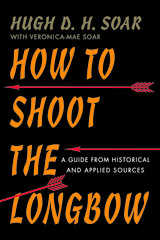 How to Shoot the Longbow: A Guide from Historical and Applied Sources
Hugh D. H. Soar
Westholme Publishing, 2015 A Leading Expert on Traditional Archery Offers Insight Into How the Longbow Was Drawn from Medieval Sources to Modern Recreations
“Soar’s book [The Crooked Stick] is indispensible.”—Bernard Cornwell, New York Times bestselling author
Relying on more than fifty years’ experience in archery, historian Hugh D. H. Soar reflects on how the longbow was drawn and shot across the centuries through examining the design of the bow and early literature about the bow, combined with his and his colleagues’ applied knowledge using replica bows. No complete medieval longbow has survived, but those found aboard the Tudor warship Mary Rose provide the best archaeological evidence to the possible construction of the medieval bow. Contemporary treatises written about the proper manner of shooting the bow, together with the resurgence in interest and construction of replica bows beginning in the late sixteenth century that form part of the author’s collection provide the basis for this work. How to Shoot the Longbow: A Guide from Historical and Applied Sources is a fascinating and practical look at the use of a legendary invention.
 How to Stage Greek Tragedy Today
Simon Goldhill
University of Chicago Press, 2007 From the stages of Broadway and London to university campuses, Paris, and the bourgeoning theaters of Africa, Greek tragedy remains constantly in production. This global revival, in addition to delighting audiences, has highlighted both the promise and the pitfalls of staging ancient masterpieces in the modern age. Addressing the issues and challenges these performances pose, renowned classicist Simon Goldhill responds here to the growing demand for a comprehensive guide to staging Greek tragedy today.
In crisp and spirited prose, Goldhill explains how Aeschylus, Euripides, and Sophocles conceived their works in performance and then summarizes everything we know about how their tragedies were actually staged. The heart of his book tackles the six major problems facing any company performing these works today: the staging space and concept of the play; the use of the chorus; the actor’s role in an unfamiliar style of performance; the place of politics in tragedy; the question of translation; and the treatment of gods, monsters, and other strange characters of the ancient world. Outlining exactly what makes each of these issues such a pressing difficulty for modern companies, Goldhill provides insightful solutions drawn from his nimble analyses of some of the best recent productions in the United States, Britain, and Continental Europe.
One of the few experts on both Greek tragedy and contemporary performance, Goldhill uses his unique background and prodigious literary skill to illuminate brilliantly what makes tragedy at once so exciting and so tricky to get right. The result will inspire and enlighten all directors and performers—not to mention the growing audiences—of ancient Greek theater.
How to Start a Farm Stop: A Pattern Language for Local Food Systems
Kathryn Barr
Michigan Publishing, 2023 Our current agricultural system favors large-scale, industrialized farms made to produce monocrops that are shipped all over the world. Consumers are sold on the idea that this system keeps food cheap and affordable, but it also means that middlemen take much of the profits while greenhouse gas emissions run high. The Argus Farm Stop in Ann Arbor, Michigan’s model provides economic and cultural benefits as well as enhanced resiliency for the farmers and communities they serve. This guidebook outlines the benefits and challenges of implementing this consignment-based business model. It highlights best practices, offers resources and technical assistance for the establishment of additional Farm Stops around the country, and prioritizes the development of regional, circular sustainable food systems that empower local farmers and enrich communities.
How to Study Art Worlds: On the Societal Functioning of Aesthetic Values
Hans van Maanen
Amsterdam University Press, 2009
While numerous studies over the years have focused on the ways in which art functions in our society, How to Study Art Worlds is the first to examine it in light of the organizational aspects of the art world. Van Maanen delves into the works of such sociologists as Howard S. Becker, Pierre Bourdieu, George Dickie, and Niklas Luhmann, among others, to examine the philosophical debates surrounding aesthetic experience—and then traces the consequences that each of these approaches has had and continues to have on organizations in the art world.
 How to Study Public Life
Jan Gehl and Birgitte Svarre
Island Press, 2013 How do we accommodate a growing urban population in a way that is sustainable, equitable, and inviting? This question is becoming increasingly urgent to answer as we face diminishing fossil-fuel resources and the effects of a changing climate while global cities continue to compete to be the most vibrant centers of culture, knowledge, and finance.
Jan Gehl has been examining this question since the 1960s, when few urban designers or planners were thinking about designing cities for people. But given the unpredictable, complex and ephemeral nature of life in cities, how can we best design public infrastructure—vital to cities for getting from place to place, or staying in place—for human use? Studying city life and understanding the factors that encourage or discourage use is the key to designing inviting public space.
In How to Study Public Life Jan Gehl and Birgitte Svarre draw from their combined experience of over 50 years to provide a history of public-life study as well as methods and tools necessary to recapture city life as an important planning dimension.
This type of systematic study began in earnest in the 1960s, when several researchers and journalists on different continents criticized urban planning for having forgotten life in the city. City life studies provide knowledge about human behavior in the built environment in an attempt to put it on an equal footing with knowledge about urban elements such as buildings and transport systems. Studies can be used as input in the decision-making process, as part of overall planning, or in designing individual projects such as streets, squares or parks. The original goal is still the goal today: to recapture city life as an important planning dimension. Anyone interested in improving city life will find inspiration, tools, and examples in this invaluable guide.
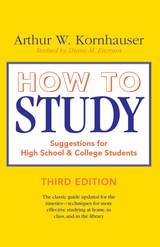 How to Study: Suggestions for High-School and College Students
Arthur W. Kornhauser
University of Chicago Press, 1993 A complete guide for successful studying, How to Study is concise, practical, time-tested, and free of gimmicks. Designed originally for freshmen at the University of Chicago, this smart book has helped generations of students throughout the country improve their skills in learning quickly and effectively. It offers a no-nonsense plan of action filled with techniques, strategies, exercises, and advice for:
*Mastering rather than just memorizing material
*Learning the secrets of mental preparation before tackling difficult assignments or exams
*Strengthening skills for better reading, note taking, and listening
*Improving use of time in the classroom, the library, and at home
It offers a wealth of advice, from the commonsensical ("Never begin study immediately after eating" and "Check every tendency to daydream") to the more psychological ("Use your knowledge by thinking, talking, and writing about the things you are learning").
Thoroughly revised and updated, this powerful little book can help any motivated and capable student work smarter, not just harder, from high school through college.
When he wrote How to Study Arthur W. Kornhauser (1896-1990) was associate professor of business psychology at the University of Chicago.
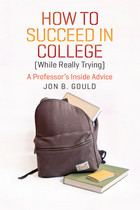 How to Succeed in College (While Really Trying): A Professor's Inside Advice
Jon B. Gould
University of Chicago Press, 2010 After years of preparation and anticipation, many students arrive at college without any real knowledge of the ins and outs of college life. They’ve been focused on finding the right school and have been carefully guided through the nuances of the admissions process, but too often they have little knowledge about how college will be different from high school or what will be expected of them during that crucial first year and beyond. Written by an award-winning teacher, How to Succeed in College (While Really Trying) provides much-needed help to students, offering practical tips and specific study strategies that will equip them to excel in their new environment.
Drawing on years of experience teaching at a variety of campuses, from large research universities to small liberal arts colleges, Jon B. Gould gives readers the lay of the land and demystifies the college experience. In the course of the book, students will learn how to identify the best instructors, how to choose classes and settle on a major, how to develop effective strategies for reading and note taking, and how to write good papers and successfully complete exams.
Because much of the college experience takes place outside of the classroom, Gould also advises students on how to effectively manage their cocurricular activities, work obligations, and free time, as well as how to take advantage of the typically untapped resources on every campus. With candid advice and insights from a seasoned insider, this guide will leave students better prepared not only to succeed in college but to enjoy it as well.
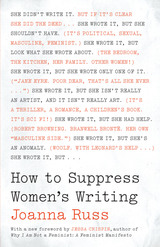 How to Suppress Women's Writing
By Joanna Russ; foreword by Jessa Crispin
University of Texas Press, 2018 Are women able to achieve anything they set their minds to? In How to Suppress Women’s Writing, award-winning novelist and scholar Joanna Russ lays bare the subtle—and not so subtle—strategies that society uses to ignore, condemn, or belittle women who produce literature. As relevant today as when it was first published in 1983, this book has motivated generations of readers with its powerful feminist critique. “What is it going to take to break apart these rigidities? Russ’s book is a formidable attempt. It is angry without being self-righteous, it is thorough without being exhausting, and it is serious without being devoid of a sense of humor. But it was published over thirty years ago, in 1983, and there’s not an enormous difference between the world she describes and the world we inhabit.”
—Jessa Crispin, from the foreword “A book of the most profound and original clarity. Like all clear-sighted people who look and see what has been much mystified and much lied about, Russ is quite excitingly subversive. The study of literature should never be the same again.”
—Marge Piercy “Joanna Russ is a brilliant writer, a writer of real moral passion and high wit.”
—Adrienne Rich
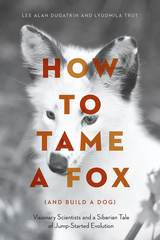 How to Tame a Fox (and Build a Dog): Visionary Scientists and a Siberian Tale of Jump-Started Evolution
Lee Alan Dugatkin and Lyudmila Trut
University of Chicago Press, 2017 Tucked away in Siberia, there are furry, four-legged creatures with wagging tails and floppy ears that are as docile and friendly as any lapdog. But, despite appearances, these are not dogs—they are foxes. They are the result of the most astonishing experiment in breeding ever undertaken—imagine speeding up thousands of years of evolution into a few decades. In 1959, biologists Dmitri Belyaev and Lyudmila Trut set out to do just that, by starting with a few dozen silver foxes from fox farms in the USSR and attempting to recreate the evolution of wolves into dogs in real time in order to witness the process of domestication. This is the extraordinary, untold story of this remarkable undertaking.
Most accounts of the natural evolution of wolves place it over a span of about 15,000 years, but within a decade, Belyaev and Trut’s fox breeding experiments had resulted in puppy-like foxes with floppy ears, piebald spots, and curly tails. Along with these physical changes came genetic and behavioral changes, as well. The foxes were bred using selection criteria for tameness, and with each generation, they became increasingly interested in human companionship. Trut has been there the whole time, and has been the lead scientist on this work since Belyaev’s death in 1985, and with Lee Dugatkin, biologist and science writer, she tells the story of the adventure, science, politics, and love behind it all. In How to Tame a Fox, Dugatkin and Trut take us inside this path-breaking experiment in the midst of the brutal winters of Siberia to reveal how scientific history is made and continues to be made today.
To date, fifty-six generations of foxes have been domesticated, and we continue to learn significant lessons from them about the genetic and behavioral evolution of domesticated animals. How to Tame a Fox offers an incredible tale of scientists at work, while also celebrating the deep attachments that have brought humans and animals together throughout time.
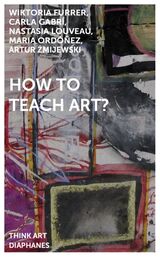 How to Teach Art?
Wiktoria Furrer, Carla Gabrí, Nastasia Louveau, Maria Ordoñez, and Artur Zmijewski
Diaphanes, 2021 A cooperative reflection on how to teach art.
How should art be taught? What kind of knowledge should artists absorb? How might an ordinary person become a creature addicted to the creative process? In other words, how can a non-artist become an artist? Such programmatic questions articulated by acclaimed Polish artist Artur Żmijewski were at the heart of the workshop “How to Teach Art?” Żmijewski invited a group of graduate and doctoral students from three Zurich universities—the Swiss Federal Institute of Technology, the University of Zurich, and the Zurich University of the Arts—to collectively reflect on their artistic practices. Over the course of four months, the group met several times a week for hourlong sessions, following individual and collective exercises induced by Żmijewski himself.
This book retraces the workshop and its process by showing inconclusive, fragmentary results between theory and practice. How to Teach Art? presents drawings, videos, photographs, 16mm films, and accompanying reflections on the central premise, “How to teach art?”
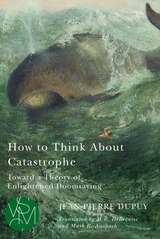 How to Think About Catastrophe: Toward a Theory of Enlightened Doomsaying
Jean-Pierre Dupuy
Michigan State University Press, 2022 During the last century humanity acquired the ability to destroy itself. The direct approach to destruction can be seen in such facts as the ever-present threat of nuclear war, but we have also developed the capacity to do indirect harm by altering conditions necessary for survival, including the looming cloud of climate change. How can we look forward and work past the dire position we now find ourselves in to achieve a sustainable future? This volume presents a new way of thinking about the future as it examines catastrophe and the human response. It examines different kinds of catastrophes that range from natural (e.g., earthquakes) to industrial (e.g., Chernobyl) and concludes that the traditional distinctions between them are only becoming blurrier by the day. This book aims to build a general theory of catastrophes—a new form of apocalyptic thinking that is grounded in science and philosophy. An ethics for the sake of the future is what is required, which in turn necessitates a new metaphysics of temporality. If a way out of the imminent danger in which we find ourselves is to be found, we must first look to radically alter our ethics.
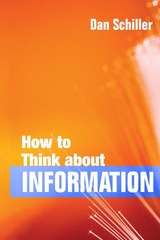 How to Think about Information
Dan Schiller
University of Illinois Press, 2006 It is common wisdom that the U.S. economy has adapted to losses in its manufacturing base because of the booming information sector, with high-paying jobs for everything from wireless networks to video games. We are told we live in the Information Age, in which communications networks and media and information services drive the larger economy. While the Information Age may have looked sunny in the beginning, as it has developed it looks increasingly ominous: its economy and benefits grow more and more centralized--and in the United States, it has become less and less subject to democratic oversight. Corporations around the world have identified the value of information and are now seeking to control its production, transmission, and consumption. In How to Think about Information, Dan Schiller explores the ways information has been increasingly commodified as a result and how it both resembles and differs from other commodities. Through a linked series of theoretical, historical, and contemporary studies, Schiller reveals this commodification as both dynamic and expansionary, but also deeply conflicted and uncertain. He examines the transformative political and economic changes occurring throughout the informational realm and analyzes key dimensions of the process, including the buildup of new technological platforms, the growth of a transnationalizing culture industry, and the role played by China as it reinserts itself into an informationalized capitalism.
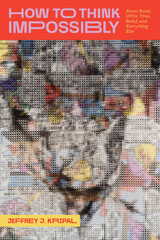 How to Think Impossibly: About Souls, UFOs, Time, Belief, and Everything Else
Jeffrey J. Kripal
University of Chicago Press, 2024 A mind-bending invitation to experience the impossible as fundamentally human.
From precognitive dreams and telepathic visions to near-death experiences, UFO encounters, and beyond, so-called impossible phenomena are not supposed to happen. But they do happen—all the time. Jeffrey J. Kripal asserts that the impossible is a function not of reality but of our everchanging assumptions about what is real. How to Think Impossibly invites us to think about these fantastic (yet commonplace) experiences as an essential part of being human, expressive of a deeply shared reality that is neither mental nor material but gives rise to both. Thinking with specific individuals and their extraordinary experiences in vulnerable, open, and often humorous ways, Kripal interweaves humanistic and scientific inquiry to foster an awareness that the fantastic is real, the supernatural is super natural, and the impossible is possible.
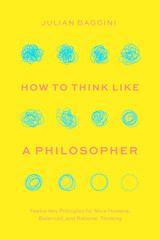 How to Think like a Philosopher: Twelve Key Principles for More Humane, Balanced, and Rational Thinking
Julian Baggini
University of Chicago Press, 2023 An invitation to the habits of good thinking from philosopher Julian Baggini.
By now, it should be clear: in the face of disinformation and disaster, we cannot hot take, life hack, or meme our way to a better future. But how should we respond instead? In How to Think like a Philosopher, Julian Baggini turns to the study of reason itself for practical solutions to this question, inspired by our most eminent philosophers, past and present.
Baggini offers twelve key principles for a more humane, balanced, and rational approach to thinking: pay attention; question everything (including your questions); watch your steps; follow the facts; watch your language; be eclectic; be a psychologist; know what matters; lose your ego; think for yourself, not by yourself; only connect; and don’t give up. Each chapter is chockful of real-world examples showing these principles at work—from the discovery of penicillin to the fight for trans rights—and how they lead to more thoughtful conclusions. More than a book of tips and tricks (or ways to be insufferably clever at parties), How to Think like a Philosopher is an invitation to develop the habits of good reasoning that our world desperately needs.
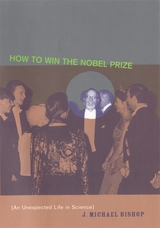 How to Win the Nobel Prize: An Unexpected Life in Science
J. Michael Bishop
Harvard University Press, 2004 In 1989 Michael Bishop and Harold Varmus were awarded the Nobel Prize for their discovery that normal genes under certain conditions can cause cancer. In this book, Bishop tells us how he and Varmus made their momentous discovery. More than a lively account of the making of a brilliant scientist, How to Win the Nobel Prize is also a broader narrative combining two major and intertwined strands of medical history: the long and ongoing struggles to control infectious diseases and to find and attack the causes of cancer.
Alongside his own story, that of a youthful humanist evolving into an ambivalent medical student, an accidental microbiologist, and finally a world-class researcher, Bishop gives us a fast-paced and engrossing tale of the microbe hunters. It is a narrative enlivened by vivid anecdotes about our deadliest microbial enemies--the Black Death, cholera, syphilis, tuberculosis, malaria, smallpox, HIV--and by biographical sketches of the scientists who led the fight against these scourges.
Bishop then provides an introduction for nonscientists to the molecular underpinnings of cancer and concludes with an analysis of many of today's most important science-related controversies--ranging from stem cell research to the attack on evolution to scientific misconduct. How to Win the Nobel Prize affords us the pleasure of hearing about science from a brilliant practitioner who is a humanist at heart. Bishop's perspective will be valued by anyone interested in biomedical research and in the past, present, and future of the battle against cancer.
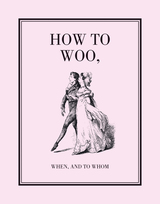 How to Woo, When, and to Whom
W. H. Collingridge
Bodleian Library Publishing, 2006 Before eHarmony.com, speed dating, and The Rules, there was W.H. Collingridge and his no-nonsense guide, How to Woo, When, and to Whom. Originally published in 1855 and newly reprinted here, How to Woo wrestles with the same problems men and women face today: seeking, seducing, and snaring a suitable mate.
The book addresses every step in navigating the perilous territory of love, from instructions on writing love letters to the rules of public displays of affection to gracefully dealing with rejection. Also included are the most important characteristics to keep in mind when choosing The One, such as age, health, fortune, morals, and social position. On marriage, Collingridge wisely advises: “Both men and women vary greatly as to the age at which they arrive at maturity; marriage should never be undertaken before that age, and generally never after.” Even so, Collingridge lauds marriage as an institution of virtues, noting how young men’s “intellects become sharpened, their morals improved, and their energy, by certain necessity, enlarged.” (He does not, interestingly enough, note what marriage does for women.) Passages of verse by such famed literary figures as Shakespeare, Boswell, Dr. Johnson, and Lady Mary Wortley Montagu accompany the sensible advice, providing an array of poetic passages that capture the tumultuous and timeless emotions of love and rejection.
Even though today’s social scene is more analogous to Sex and the City than Emma, much of the counsel in How to Woo is surprisingly applicable to contemporary daters. An invaluable resource for both lovers and the lovelorn, How to Woo is a delightful handbook on the age-old art of courting.
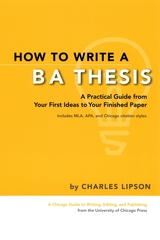 How to Write a BA Thesis: A Practical Guide from Your First Ideas to Your Finished Paper
Charles Lipson
University of Chicago Press, 2005 The senior thesis is the capstone of a college education, but writing one can be a daunting prospect. Students need to choose their own topic and select the right adviser. Then they need to work steadily for several months as they research, write, and manage a major independent project. Now there's a mentor to help. How to Write a BA Thesis is a practical, friendly guide written by Charles Lipson, an experienced professor who has guided hundreds of students through the thesis-writing process.
This book offers step-by-step advice on how to turn a vague idea into a clearly defined proposal, then a draft paper, and, ultimately, a polished thesis. Lipson also tackles issues beyond the classroom-from good work habits to coping with personal problems that interfere with research and writing.
Filled with examples and easy-to-use highlighted tips, the book also includes handy time schedules that show when to begin various tasks and how much time to spend on each. Convenient checklists remind students which steps need special attention, and a detailed appendix, filled with examples, shows how to use the three main citation systems in the humanities and social sciences: MLA, APA, and Chicago.
How to Write a BA Thesis will help students work more comfortably and effectively-on their own and with their advisers. Its clear guidelines and sensible advice make it the perfect text for thesis workshops. Students and their advisers will refer again and again to this invaluable resource. From choosing a topic to preparing the final paper, How to Write a BA Thesis helps students turn a daunting prospect into a remarkable achievement.
How to Write a BA Thesis, Second Edition: A Practical Guide from Your First Ideas to Your Finished Paper
Charles Lipson
University of Chicago Press, 2018 How to Write a BA Thesis is the only book that directly addresses the needs of undergraduate students writing a major paper. This book offers step-by-step advice on how to move from early ideas to finished paper. It covers choosing a topic, selecting an advisor, writing a proposal, conducting research, developing an argument, writing and editing the thesis, and making through a defense. Lipson also acknowledges the challenges that arise when tackling such a project, and he offers advice for breaking through writer’s block and juggling school-life demands. This is a must-read for anyone writing a BA thesis, or for anyone who advises these students.
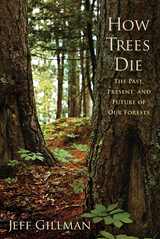 How Trees Die: The Past, Present, and Future of our Forests
Jeff Gillman
Westholme Publishing, 2009 Lessons About Our Environment from the World’s Oldest Living Things
Trees have been essential to the success of human beings, providing food, shelter, warmth, transportation, and products (consider the paper you are holding). Trees are also necessary for a healthy atmosphere, literally connecting the earth with the sky. Once in wild abundance— the entire eastern North America was a gigantic forest—they have receded as we have clearcut the landscape in favor of building cities and farms, using up and abusing our forests in the process. Over the centuries, we have trained food trees, such as peach and apple trees, to produce more and better fruit at the expense of their lives. As Jeff Gillman, a specialist in the production and care of trees, explains in his acclaimed work, How Trees Die: The Past, Present, and Future of Our Forests, the death of a tree is as important to understanding our environment as how it lives. While not as readily apparent as other forms of domestication, our ancient and intimate relationship with trees has caused their lives to be inseparably entwined with ours. The environment we have created—what we put into the air and into the water, and how we change the land through farming, construction, irrigation, and highways—affects the world’s entire population of trees, while the lives of the trees under our direct care in farms, orchards, or along a city boulevard depend almost entirely on our actions. Taking the reader on a fascinating journey through time and place, the author explains how we kill trees, often for profit, but also unintentionally with kindness through overwatering or overmulching, and sometimes simply by our movements around the globe, carrying foreign insects or disease. No matter how a tree’s life ends, though, understanding the reason is essential to understanding the future of our environment.
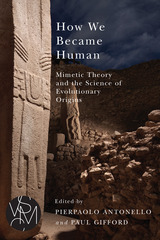 How We Became Human: Mimetic Theory and the Science of Evolutionary Origins
Pierpaolo Antonello
Michigan State University Press, 2015 From his groundbreaking Violence and the Sacred and Things Hidden since the Foundation of the World, René Girard’s mimetic theory is presented as elucidating “the origins of culture.” He posits that archaic religion (or “the sacred”), particularly in its dynamics of sacrifice and ritual, is a neglected and major key to unlocking the enigma of “how we became human.” French philosopher of science Michel Serres states that Girard’s theory provides a Darwinian theory of culture because it “proposes a dynamic, shows an evolution and gives a universal explanation.” This major claim has, however, remained underscrutinized by scholars working on Girard’s theory, and it is mostly overlooked within the natural and social sciences. Joining disciplinary worlds, this book aims to explore this ambitious claim, invoking viewpoints as diverse as evolutionary culture theory, cultural anthropology, archaeology, cognitive psychology, ethology, and philosophy. The contributors provide major evidence in favor of Girard’s hypothesis. Equally, Girard’s theory is presented as having the potential to become for the human and social sciences something akin to the integrating framework that present-day biological science owes to Darwin—something compatible with it and complementary to it in accounting for the still remarkably little understood phenomenon of human emergence.
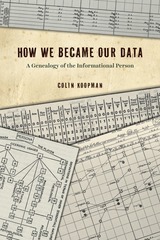 How We Became Our Data: A Genealogy of the Informational Person
Colin Koopman
University of Chicago Press, 2019 We are now acutely aware, as if all of the sudden, that data matters enormously to how we live. How did information come to be so integral to what we can do? How did we become people who effortlessly present our lives in social media profiles and who are meticulously recorded in state surveillance dossiers and online marketing databases? What is the story behind data coming to matter so much to who we are?
In How We Became Our Data, Colin Koopman excavates early moments of our rapidly accelerating data-tracking technologies and their consequences for how we think of and express our selfhood today. Koopman explores the emergence of mass-scale record keeping systems like birth certificates and social security numbers, as well as new data techniques for categorizing personality traits, measuring intelligence, and even racializing subjects. This all culminates in what Koopman calls the “informational person” and the “informational power” we are now subject to. The recent explosion of digital technologies that are turning us into a series of algorithmic data points is shown to have a deeper and more turbulent past than we commonly think. Blending philosophy, history, political theory, and media theory in conversation with thinkers like Michel Foucault, Jürgen Habermas, and Friedrich Kittler, Koopman presents an illuminating perspective on how we have come to think of our personhood—and how we can resist its erosion.
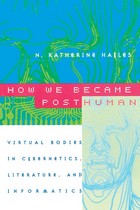 How We Became Posthuman: Virtual Bodies in Cybernetics, Literature, and Informatics
N. Katherine Hayles
University of Chicago Press, 1999 In this age of DNA computers and artificial intelligence, information is becoming disembodied even as the "bodies" that once carried it vanish into virtuality. While some marvel at these changes, envisioning consciousness downloaded into a computer or humans "beamed" Star Trek-style, others view them with horror, seeing monsters brooding in the machines. In How We Became Posthuman, N. Katherine Hayles separates hype from fact, investigating the fate of embodiment in an information age.
Hayles relates three interwoven stories: how information lost its body, that is, how it came to be conceptualized as an entity separate from the material forms that carry it; the cultural and technological construction of the cyborg; and the dismantling of the liberal humanist "subject" in cybernetic discourse, along with the emergence of the "posthuman."
Ranging widely across the history of technology, cultural studies, and literary criticism, Hayles shows what had to be erased, forgotten, and elided to conceive of information as a disembodied entity. Thus she moves from the post-World War II Macy Conferences on cybernetics to the 1952 novel Limbo by cybernetics aficionado Bernard Wolfe; from the concept of self-making to Philip K. Dick's literary explorations of hallucination and reality; and from artificial life to postmodern novels exploring the implications of seeing humans as cybernetic systems.
Although becoming posthuman can be nightmarish, Hayles shows how it can also be liberating. From the birth of cybernetics to artificial life, How We Became Posthuman provides an indispensable account of how we arrived in our virtual age, and of where we might go from here.
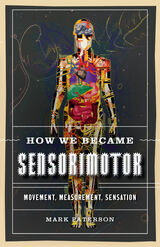 How We Became Sensorimotor: Movement, Measurement, Sensation
Mark Paterson
University of Minnesota Press, 2021 An engrossing history of the century that transformed our knowledge of the body’s inner senses
The years between 1833 and 1945 fundamentally transformed science’s understanding of the body’s inner senses, revolutionizing fields like philosophy, the social sciences, and cognitive science. In How We Became Sensorimotor, Mark Paterson provides a systematic account of this transformative period, while also demonstrating its substantial implications for current explorations into phenomenology, embodied consciousness, the extended mind, and theories of the sensorimotor, the body, and embodiment. Each chapter of How We Became Sensorimotor takes a particular sense and historicizes its formation by means of recent scientific studies, case studies, or coverage in the media. Ranging among a diverse array of sensations, including balance, fatigue, pain, the “muscle sense,” and what Maurice Merleau-Ponty termed “motricity,” Paterson’s analysis moves outward from the familiar confines of the laboratory to those of the industrial world and even to wild animals and their habitats. He uncovers important stories, such as how forgotten pain-measurement schemes transformed criminology, or how Penfield’s outmoded concepts of the sensory and motor homunculi of the brain still mar psychology textbooks. Complete with original archival research featuring illustrations and correspondence, How We Became Sensorimotor shows how the shifting and sometimes contested historical background to our understandings of the senses are being extended even today.
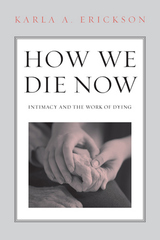 How We Die Now: Intimacy and the Work of Dying
Karla Erickson
Temple University Press, 2013 As we live longer and die slower and differently than our ancestors, we have come to rely more and more on end-of-life caregivers. These workers navigate a changing landscape of old age and death that many of us have little preparation to encounter. How We Die Now is an absorbing and sensitive investigation of end-of-life issues from the perspectives of patients, relatives, medical professionals, and support staff. Karla Erickson immersed herself in the daily life of workers and elders in a Midwestern community for over two years to explore important questions around the theme of “how we die now.” She moves readers through and beyond the many fears that attend the social condition of old age and reveals the pleasures of living longer and the costs of slower, sometimes senseless ways of dying. For all of us who are grappling with the “elder boom,” How We Die Now offers new ways of thinking about our longer lives.
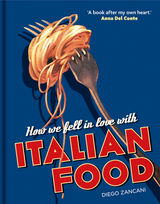 How We Fell in Love with Italian Food
Diego Zancani
Bodleian Library Publishing, 2019 Pizza, pasta, and olive oil: today, it’s hard to imagine any supermarket without these items. But how did these foods—and many more Italian ingredients—become so widespread?
In this book, Diego Zancani maps the extraordinary progress of Italian food, from the legacy of the Roman invasion to its current, ever-increasing popularity. Starting with medieval manuscripts, he traces Italian recipes in Britain back to the thirteenth century, and draws on later travel diaries to explore British and American encounters with Italian food abroad. The book also shows how Italian immigrants, from ice-cream sellers and grocers to chefs and restauranteurs, had a transformative influence on the spread of the cuisine, championing Italian food at pivotal moments throughout history.
Lavishly illustrated with material from the archives of the Bodleian Library and elsewhere, this sumptuous book also includes Italian regional recipes that have come down to us through the centuries, and celebrates the enduring international appeal of delicatessens, pizzerias, trattorias, and the Mediterranean diet.
How We Learn Where We Live: Thomas Bernhard, Architecture, and Bildung
Fatima Naqvi
Northwestern University Press, 2015 How We Learn Where We Live opens new avenues into thinking about one of the most provocative writers of the twentieth century, Thomas Bernhard. In one of the first English studies of his work, Fatima Naqvi focuses on the Austrian author’s critique of education (Bildung) through the edifices in which it takes place. She demonstrates that both literature and architecture are implicated in the concept of Bildung. His writings insist that learning has always been a life-long process that is helped—or hindered—by the particular buildings in which Bildung occurs. Naqvi offers close readings of Bernhard’s major prose works, from Amras (1964) to Old Masters (1985) and brings them into dialogue with major architectural debates of the times. She examines Bernard’s interrogation of the theoretical foundations underpinning the educational system and its actual sites.
 How We Live: An Economic Perspective on Americans from Birth to Death
Victor Fuchs
Harvard University Press, 1983 Victor Fuchs, author of Who Shall Live?, cuts through the hand wringing and the “pop” panaceas for America's current social crises in a brilliant analysis of the way we live. The facts are familiar. A doubled rate of divorce. A birth rate cut nearly in half while the percentage of illegitimate births nearly tripled. The young face dismal job prospects, and many of the old are totally dependent on the federal government.
Fuchs's economic approach shows us that the societal upheaval of American life is not created by fiat but rather emerges as millions of men and women make seemingly small choices that are constrained by their circumstances: “Should I go back to school?” “How many children should we have?” “When should I retire?” In a masterly synthesis, he shows the interrelatedness of our choices regarding family, work, health, and education throughout the life cycle. He uses the latest facts of American life to explore three major themes—the fading family, the impact of simple demographics on individual destiny, and the effect of weighing present and future costs and benefits on individual choice.
Fuchs concludes by offering innovative solutions to many contemporary problems: social security, health insurance, child care, youth unemployment, and illegitimate births. Moving beyond the outworn orthodoxies of liberalism and conservatism, he offers a clearer view of our circumstances so that readers from all walks of life can make better private choices, and contribute to more effective public policies.
 How We Make Each Other: Trans Life at the Edge of the University
Perry Zurn
Duke University Press, 2025 Trans people have always lived in the cracks of institutions—and the university is no exception. In How We Make Each Other, Perry Zurn tells the stories of how trans people make and live their lives at the edges of the university in ways that sometimes lead to policy change but always leave participants and institutions different than they were before. Using the Five Colleges in Massachusetts as a case study, Zurn notes that Amherst College, Hampshire College, Mount Holyoke College, Smith College, and the University of Massachusetts, Amherst, have been at the forefront of developing trans-inclusive policies in higher education, often in response to student organizing. Zurn focuses on the stories of trans students, staff, faculty, and community members within and alongside these institutions, exploring how they have built themselves and each other. Drawing on official archives as well as over 100 interviews, Zurn shows how trans people in the Five Colleges have made history, forged resistance habits, and cultivated hope.
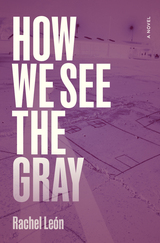 How We See the Gray: A Novel
Rachel León
Northwestern University Press, 2026 A riveting story about parenthood, substance abuse, and the strength it takes to come back from our mistakes Foster care is a disaster in Rockford, Illinois. Meredith, a social worker and single mom, is stretched beyond thin but determined to protect her kids: not only her son, but those on her caseload too. When the stress of the job has her breaking her sobriety, the foundations of her life begin to tremble. After drinking too much, she makes a mistake that puts her preschooler in jeopardy, and Meredith finds herself in a situation that mirrors her clients’ as she loses custody of her son. In her fight to get him back, Meredith experiences the system from the outside—while still working for the kids inside of it. Set over the course of a year, this riveting documentary-esque novel is told from multiple perspectives, including those of case workers, birth parents, foster parents, and foster children. Written with the working-class humor and heart that defines the Midwest, How We See the Gray is a story about mistakes, second chances, and trying to do better in a system that seems doomed to fail.
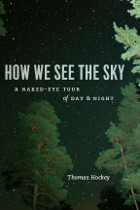 How We See the Sky: A Naked-Eye Tour of Day and Night
Thomas Hockey
University of Chicago Press, 2002 Gazing up at the heavens from our backyards or a nearby field, most of us see an undifferentiated mess of stars—if, that is, we can see anything at all through the glow of light pollution. Today’s casual observer knows far less about the sky than did our ancestors, who depended on the sun and the moon to tell them the time and on the stars to guide them through the seas. Nowadays, we don’t need the sky, which is good, because we’ve made it far less accessible, hiding it behind the skyscrapers and the excessive artificial light of our cities.
How We See the Sky gives us back our knowledge of the sky, offering a fascinating overview of what can be seen there without the aid of a telescope. Thomas Hockey begins by scanning the horizon, explaining how the visible universe rotates through this horizon as night turns to day and season to season. Subsequent chapters explore the sun’s and moon’s respective motions through the celestial globe, as well as the appearance of solstices, eclipses, and planets, and how these are accounted for in different kinds of calendars. In every chapter, Hockey introduces the common vocabulary of today’s astronomers, uses examples past and present to explain them, and provides conceptual tools to help newcomers understand the topics he discusses.
Packed with illustrations and enlivened by historical anecdotes and literary references, How We See the Sky reacquaints us with the wonders to be found in our own backyards.
How We Sleep on the Nights We Don't Make Love
E. Ethelbert Miller
Northwestern University Press, 2004 In this wide-ranging collection of lyrics, dealing with themes such as family, love, racism, and war, E. Ethelbert Miller sets his scenes against the backdrop of the stark realities of contemporary life, here and abroad. As both his love poems and political poems attest, Miller believes with full faith in the transformative powers of love and understanding. His poems on friendship and love are tender, often whimsical. His political poems are evenhanded and compassionate.
 How We Teach Science: What’s Changed, and Why It Matters
John L. Rudolph
Harvard University Press, 2019 A former Wisconsin high school science teacher makes the case that how and why we teach science matters, especially now that its legitimacy is under attack.
Why teach science? The answer to that question will determine how it is taught. Yet despite the enduring belief in this country that science should be taught, there has been no enduring consensus about how or why.
This is especially true when it comes to teaching scientific process. Nearly all of the basic knowledge we have about the world is rock solid. The science we teach in high schools in particular—laws of motion, the structure of the atom, cell division, DNA replication, the universal speed limit of light—is accepted as the way nature works. Everyone also agrees that students and the public more generally should understand the methods used to gain this knowledge. But what exactly is the scientific method?
Ever since the late 1800s, scientists and science educators have grappled with that question. Through the years, they’ve advanced an assortment of strategies, ranging from “the laboratory method” to the “five-step method” to “science as inquiry” to no method at all. How We Teach Science reveals that each strategy was influenced by the intellectual, cultural, and political circumstances of the time. In some eras, learning about experimentation and scientific inquiry was seen to contribute to an individual’s intellectual and moral improvement, while in others it was viewed as a way to minimize public interference in institutional science.
John Rudolph shows that how we think about and teach science will either sustain or thwart future innovation, and ultimately determine how science is perceived and received by the public.
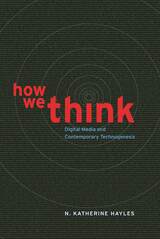 How We Think: Digital Media and Contemporary Technogenesis
N. Katherine Hayles
University of Chicago Press, 2012 “How do we think?” N. Katherine Hayles poses this question at the beginning of this bracing exploration of the idea that we think through, with, and alongside media. As the age of print passes and new technologies appear every day, this proposition has become far more complicated, particularly for the traditionally print-based disciplines in the humanities and qualitative social sciences. With a rift growing between digital scholarship and its print-based counterpart, Hayles argues for contemporary technogenesis—the belief that humans and technics are coevolving—and advocates for what she calls comparative media studies, a new approach to locating digital work within print traditions and vice versa. Hayles examines the evolution of the field from the traditional humanities and how the digital humanities are changing academic scholarship, research, teaching, and publication. She goes on to depict the neurological consequences of working in digital media, where skimming and scanning, or “hyper reading,” and analysis through machine algorithms are forms of reading as valid as close reading once was. Hayles contends that we must recognize all three types of reading and understand the limitations and possibilities of each. In addition to illustrating what a comparative media perspective entails, Hayles explores the technogenesis spiral in its full complexity. She considers the effects of early databases such as telegraph code books and confronts our changing perceptions of time and space in the digital age, illustrating this through three innovative digital productions—Steve Tomasula’s electronic novel, TOC; Steven Hall’s The Raw Shark Texts; and Mark Z. Danielewski’s Only Revolutions. Deepening our understanding of the extraordinary transformative powers digital technologies have placed in the hands of humanists, How We Think presents a cogent rationale for tackling the challenges facing the humanities today.
 How We Vote: Innovation in American Elections
Kathleen Hale and Mitchell Brown
Georgetown University Press, 2020 The idea of voting is simple, but the administration of elections in ways that ensure access and integrity is complex. In How We Vote, Kathleen Hale and Mitchell Brown explore what is at the heart of our democracy: how elections are run. Election administration determines how ballots are cast and counted, and how jurisdictions try to innovate while also protecting the security of the voting process, as well as how election officials work. Election officials must work in a difficult intergovernmental environment of constant change and intense partisanship. Voting practices and funding vary from state to state, and multiple government agencies, the judicial system, voting equipment vendors, nonprofit groups, and citizen activists also influence practices and limit change. Despite real challenges and pessimistic media assessments, Hale and Brown demonstrate that election officials are largely successful in their work to facilitate, protect, and evolve the voting process. Using original data gathered from state and local election officials and policymakers across the United States, Hale and Brown analyze innovations in voter registration, voting options, voter convenience, support for voting in languages other than English, the integrity of the voting process, and voting system technology. The result is a fascinating picture of how we vote now and will vote in the future.
 How We Write Now: Living with Black Feminist Theory
Jennifer C. Nash
Duke University Press, 2024 In How We Write Now Jennifer C. Nash examines how Black feminists use beautiful writing to allow writers and readers to stay close to the field’s central object and preoccupation: loss. She demonstrates how contemporary Black feminist writers and theorists such as Jesmyn Ward, Elizabeth Alexander, Christina Sharpe, and Natasha Trethewey mobilize their prose to ask readers to feel, undo, and reassemble themselves. These intimate invitations are more than a set of tools for decoding the social world; Black feminist prose becomes a mode of living and feeling, dreaming and being, and a distinctly affective project that treats loss as not only paradigmatic of Black life but also an aesthetic question. Through her own beautiful writing, Nash shows how Black feminism offers itself as a companion to readers to chart their own lives with and in loss, from devastating personal losses to organizing around the movement for Black lives. Charting her own losses, Nash reminds us that even as Black feminist writers get as close to loss as possible, it remains a slippery object that troubles memory and eludes capture.
How Welfare States Care: Culture, Gender and Parenting in Europe
Monique Kremer
Amsterdam University Press, 2007
Though women’s employment patterns in Europe have been changing drastically over several decades, the repercussions of this social revolution are just beginning to garner serious attention. Many scholars have presumed that diversity and change in women’s employment is based on the structures of welfare states and women’s responses to economic incentives and disincentives to join the workforce; How Welfare States Care provides in-depth analysis of women’s employment and childcare patterns, taxation, social security, and maternity leave provisions in order to show this logic does not hold. Combining economic, sociological, and psychological insights, Kremer demonstrates that care is embedded in welfare states and that European women are motivated by culturally and morally-shaped ideals of care that are embedded in welfare states—and less by economic reality.
How Will the Patient Protection and Affordable Care Act Affect Liability Insurance Costs?
David I. Auerbach
RAND Corporation, 2014 This report identifies potential mechanisms through which the Affordable Care Act (ACA) might affect liability claim costs and develops rough estimates of the size and direction of expected impacts as of 2016. Overall, effects of the ACA appear likely to be small relative to aggregate auto, workers’ compensation, and medical malpractice insurer payouts, but some states and insurance lines may experience cost changes as high as 5 percent or more.
How Women Must Write: Inventing the Russian Woman Poet
Olga Peters Hasty
Northwestern University Press, 2019 In How Women Must Write, Olga Peters Hasty takes us from an emphatically male Romantic age to a modernist period preoccupied with women’s creativity but also with its containment. In late nineteenth and early twentieth-century Russia, the woman poet was invented: by women poets themselves, by readers who projected gender biases into their poems, and by male poets who wrote posing as women. Examining Karolina Pavlova and Evdokiia Rostopchina, who inspired those writing after them, as well as two women invented by men, Cherubina de Gabriak and Briusov’s Nelli, and challenges to male authority by Marina Tsvetaeva and Anna Akhmatova, this book shows women as purposeful actors realizing themselves creatively and advancing the woman poet’s cause. It will appeal to the general reader and to specialists in Russian literature, women’s studies, and cultural history.
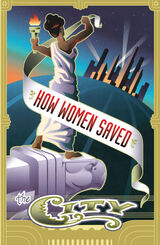 How Women Saved The City
Daphne Spain
University of Minnesota Press, 2001 Reclaims the lost history of women’s contributions to the development of American cities In the days between the Civil War and World War I, women rarely worked outside the home, rarely went to college, and, if our histories are to be believed, rarely put their mark on the urban spaces unfolding around them. And yet, as this book clearly demonstrates, women did play a key role in shaping the American urban landscape. To uncover the contribution of women to urban development during this period, Daphne Spain looks at the places where women participated most actively in public life—voluntary organizations like the Young Women’s Christian Association, the Salvation Army, the College Settlements Association, and the National Association of Colored Women. In the extensive building projects of these associations—boarding houses, vocational schools, settlement houses, public baths, and playgrounds—she finds clear evidence of a built environment created by women. Exploring this environment, Spain reconstructs the story of the "redemptive places" that addressed the real needs of city dwellers—especially single women, African-Americans, immigrants, and the poor—and established an environment in which newcomers could learn to become urban Americans.
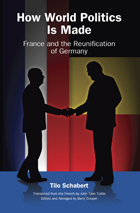 How World Politics Is Made: France and the Reunification of Germany
Tilo Schabert
University of Missouri Press, 2009
With the collapse of the Soviet Union and its Eastern European bloc, the reunification of Germany was a major episode in the history of modern Europe—and one widely held to have been opposed by that country’s centuries-old enemy, France. But while it has been previously believed that French President François Mitterrand played a negative role in events leading up to reunification, Tilo Schabert shows that Mitterrand’s main concern was not the potential threat of an old nemesis but rather that a reunified Germany be firmly anchored in a unified Europe.
Widely acclaimed in Europe and now available in English for the first time, How World Politics Is Made blends primary research and interviews with key actors in France and Germany to take readers behind the scenes of world governments as a new Europe was formed. Schabert had unprecedented, exclusive access to French presidential archives and here focuses on French diplomacy not only to dispel the notion that Mitterrand was reluctant to accept reunification but also to show how successful he was in bringing it about.
Although accounts of U.S. officials regarding the reunification of Germany boast of American leadership that guided European affairs, Schabert offers a Continental perspective that is far more complex. He reveals the constructive role played by France as he re-creates not only French cabinet meetings but also communications between Mitterrand and George H. W. Bush, Mikhail Gorbachev, Helmut Kohl, Margaret Thatcher, and other world leaders. Along the way, he provides new insight into such major episodes as the fall of the Berlin Wall, European Council summits, the German-Polish border dispute, Germany’s membership in NATO, and the final settlement of reunification.
Schabert’s work is a major piece of scholarship that clearly shows the decisive role that France played in the orchestration of German reunification—by making the “German question” a European question. A primary source in its own right, this book dramatically reshapes our understanding of not only reunification but also the end of the Cold War and the construction of a New Europe.
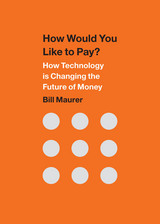 How Would You Like to Pay?: How Technology Is Changing the Future of Money
Bill Maurer
Duke University Press, 2015 From Bitcoin to Apple Pay, big changes seem to be afoot in the world of money. Yet the use of coins and paper bills has persisted for 3,000 years. In How Would You Like to Pay?, leading anthropologist Bill Maurer narrates money's history, considers its role in everyday life, and discusses the implications of how new technologies are changing how we pay. These changes are especially important in the developing world, where people who lack access to banks are using cell phones in creative ways to send and save money. To truly understand money, Maurer explains, is to understand and appreciate the complex infrastructures and social relationships it relies on. Engaging and straightforward, How Would You Like to Pay? rethinks something so familiar and fundamental in new and exciting ways. Ultimately, considering how we would like to pay gives insights into determining how we would like to live.
How Writing Came About
By Denise Schmandt-Besserat
University of Texas Press, 1996 Top 100 Books on Science, American Scientist, 2001 In 1992, the University of Texas Press published Before Writing, Volume I: From Counting to Cuneiform and Before Writing, Volume II: A Catalog of Near Eastern Tokens. In these two volumes, Denise Schmandt-Besserat set forth her groundbreaking theory that the cuneiform script invented in the Near East in the late fourth millennium B.C.—the world's oldest known system of writing—derived from an archaic counting device. How Writing Came About draws material from both volumes to present Schmandt-Besserat's theory for a wide public and classroom audience. Based on the analysis and interpretation of a selection of 8,000 tokens or counters from 116 sites in Iran, Iraq, the Levant, and Turkey, it documents the immediate precursor of the cuneiform script.
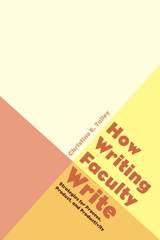 How Writing Faculty Write: Strategies for Process, Product, and Productivity
Christine E. Tulley
Utah State University Press, 2018 In How Writing Faculty Write, Christine Tulley examines the composing processes of fifteen faculty leaders in the field of rhetoric and writing, revealing through in-depth interviews how each scholar develops ideas, conducts research, drafts and revises a manuscript, and pursues publication. The book shows how productive writing faculty draw on their disciplinary knowledge to adopt attitudes and strategies that not only increase their chances of successful publication but also cultivate writing habits that sustain them over the course of their academic careers. The diverse interviews present opportunities for students and teachers to extrapolate from the personal experience of established scholars to their own writing and professional lives.
Tulley illuminates a long-unstudied corner of the discipline: the writing habits of theorists, researchers, and teachers of writing. Her interviewees speak candidly about overcoming difficulties in their writing processes on a daily basis, using strategies for getting started and restarted, avoiding writer’s block, finding and using small moments of time, and connecting their writing processes to their teaching. How Writing Faculty Write will be of significant interest to students and scholars across the spectrum—graduate students entering the discipline, new faculty and novice scholars thinking about their writing lives, mid-level and senior faculty curious about how scholars research and write, historians of rhetoric and composition, and metadisciplinary scholars.
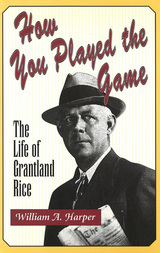 How You Played the Game: The Life of Grantland Rice
William Harper
University of Missouri Press, 1999
Centering around the life and times of the revered American sportswriter Grantland Rice (1880-1954), How You Played the Game takes us back to those magical days of sporting tales and mythic heroes. Through Rice's eyes we behold such sports as bicycle racing, boxing, golf, baseball, football, and tennis as they were played before 1950. We witness ups and downs in the careers of such legendary figures as Christy Mathewson, Jack Dempsey, Ty Cobb, Babe Ruth, Jim Thorpe, Red Grange, Bobby Jones, Bill Tilden, Notre Dame's Four Horsemen, Gene Tunney, and Babe Didrikson--all of whom Rice helped become household names.
Grantland Rice was a remarkably gifted and honorable sportswriter. From his early days in Nashville and Atlanta, to his famed years in New York, Rice was acknowledged by all for his uncanny grasp of the ins and outs of a dozen sports, as well as his personal friendship with hundreds of sportsmen and sportswomen. As a pioneer in American sportswriting, Rice helped establish and dignify the profession, sitting shoulder to shoulder in press boxes around the nation with the likes of Ring Lardner, Damon Runyon, Heywood Broun, and Red Smith.
Besides being a first-rate reporter, Rice was also a columnist, poet, magazine and book writer, film producer, family man, war veteran, fund-raiser, and skillful golfer. His personal accomplishments over a half century as an advocate for sports and good sportsmanship are astounding by any standard. What truly set Rice apart from so many of his peers, however, was the idea behind his sports reporting and writing. He believed that good sportsmanship was capable of lifting individuals, societies, and even nations to remarkable heights of moral and social action.
More than just a biography of Grantland Rice, How You Played the Game is about the rise of American sports and the early days of those who created the art and craft of sportswriting. Exploring the life of a man who perfectly blended journalism and sporting culture, this book is sure to appeal to all, sports lovers or not.
Howard Barker Interviews 1980-2010: Conversations in Catastrophe
Edited and Introduced by Mark Brown
Intellect Books, 2011 British playwright Howard Barker coined the term “theatre of catastrophe” to describe his unique brand of complex, ambiguous, and often unsettling drama. Revered in continental Europe, North America, and Australia as one of the greatest living dramatists working in the English language, Barker is also a celebrated poet, theater theorist, and painter. The first collection of interviews conducted with Barker, Howard Barker Interviews 1980–2010 covers his entire career and gives a strong sense of the life and work of this innovative dramatist.
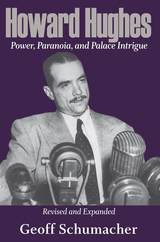 Howard Hughes: Power, Paranoia, and Palace Intrigue, Revised and Expanded
Geoff Schumacher
University of Nevada Press, 2020 This newly revised and expanded edition of Howard Hughes chronicles the life and legacies of one of the most intriguing and accomplished Americans of the twentieth century. Hughes, born into wealth thanks to his father’s innovative drill bit that transformed the oil industry, put his inheritance to work in multiple ways, from producing big-budget Hollywood movies to building the world’s fastest and largest airplanes. Hughes set air speed records and traveled around the world in record time, earning ticker-tape parades in three cities in 1938. Later, he moved to Las Vegas and invested heavily in casinos. He bought seven resorts, in each case helping to loosen organized crime’s grip on Nevada’s lifeblood industry.
Although the public viewed Hughes as a heroic and independent-minded trailblazer, behind closed doors he suffered from germophobia, obsessive-compulsive disorder, and an addiction to painkillers. He became paranoid and reclusive, surrounding himself with a small cadre of loyal caretakers. As executives battled each other over his empire, Hughes’ physical and mental health deteriorated to the point where he lost control of his business affairs.
This second edition includes more insider details on Hughes’ personal interactions with actresses, journalists, and employees. New chapters provide insights into Hughes’s involvement with the mob, his ownership and struggles as the majority shareholder of TWA and the wide-ranging activities of Hughes Aircraft Company, Hughes’s critical role in the Glomar Explorer CIA project (a deep-sea drillship platform built to recover the Soviet submarine K-129), and more. Based on in-depth interviews with individuals who knew and worked with Hughes, this fascinating biography provides a colorful and comprehensive look at Hughes—from his life and career to his final years and lasting influence. This penetrating depiction of the man behind the curtain demonstrates Hughes’s legacy, and enduring impact on popular culture.
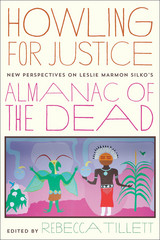 Howling for Justice: New Perspectives on Leslie Marmon Silko’s Almanac of the Dead
Edited by Rebecca Tillett
University of Arizona Press, 2014 More than twenty years after its publication in 1991, Leslie Marmon Silko’s monumental novel Almanac of the Dead continues to disconcert, move, provoke, and outrage readers. In a work that is overtly and often uncomfortably political, Silko’s overflowing cast of characters includes representatives from a range of cultures and communities who are united by common experiences of dispossession, disenfranchisement, exploitation, and poverty. Clearly, Silko’s depiction of a social uprising that draws together the indigenous People’s Army of the Americas and the American Army of the Homeless triggered—and was designed to trigger—a range of reactions among readers and critics alike.
Howling for Justice actively engages with both the literary achievements and the politics of Silko’s text. It brings together essays by international scholars reacting to the novel while keeping in mind its larger concern with issues of social justice, both local and transnational. Aiming both to refocus critical attention and open the book to a broader array of readers, this collection offers fresh perspectives on its transnational vision, on its sociocultural, historical, and political ambitions, and on its continued relevance in the twenty-first century. The essays examine and explain some of the key points that readers and critics have identified as confusing, problematic, and divisive. Together, they offer new ways to approach and appreciate the text.
The book concludes with a new, never-before-published interview in which Silko reflects on the twenty years since the novel’s publication and relates the concerns of Almanac to her current work.
HR vol 52 num 3
The University of Chicago Press
University of Chicago Press Journals, 2013
HR vol 52 num 4
The University of Chicago Press
University of Chicago Press Journals, 2013
HR vol 53 num 1
The University of Chicago Press
University of Chicago Press Journals, 2013
HR vol 53 num 2
The University of Chicago Press
University of Chicago Press Journals, 2013
HR vol 53 num 3
The University of Chicago Press
University of Chicago Press Journals, 2014
HR vol 53 num 4
The University of Chicago Press
University of Chicago Press Journals, 2014
HR vol 54 num 1
The University of Chicago Press
University of Chicago Press Journals, 2014
HR vol 54 num 2
The University of Chicago Press
University of Chicago Press Journals, 2014
HR vol 54 num 3
The University of Chicago Press
University of Chicago Press Journals, 2015
HR vol 54 num 4
The University of Chicago Press
University of Chicago Press Journals, 2015
HR vol 55 num 1
The University of Chicago Press
University of Chicago Press Journals, 2015
HR vol 55 num 2
The University of Chicago Press
University of Chicago Press Journals, 2015
HR vol 55 num 3
The University of Chicago Press
University of Chicago Press Journals, 2016
HR vol 55 num 4
The University of Chicago Press
University of Chicago Press Journals, 2016
HR vol 56 num 1
The University of Chicago Press
University of Chicago Press Journals, 2016
HR vol 56 num 2
The University of Chicago Press
University of Chicago Press Journals, 2016
HR vol 56 num 3
The University of Chicago Press
University of Chicago Press Journals, 2017
HR vol 56 num 4
The University of Chicago Press
University of Chicago Press Journals, 2017
HR vol 57 num 1
The University of Chicago Press
University of Chicago Press Journals, 2017
HR vol 57 num 2
The University of Chicago Press
University of Chicago Press Journals, 2017
HR vol 57 num 3
The University of Chicago Press
University of Chicago Press Journals, 2018
HR vol 57 num 4
The University of Chicago Press
University of Chicago Press Journals, 2018
HR vol 58 num 1
The University of Chicago Press
University of Chicago Press Journals, 2018
HR vol 58 num 2
The University of Chicago Press
University of Chicago Press Journals, 2018
HR vol 58 num 3
The University of Chicago Press
University of Chicago Press Journals, 2019
HR vol 58 num 4
The University of Chicago Press
University of Chicago Press Journals, 2019
HR vol 59 num 1
The University of Chicago Press
University of Chicago Press Journals, 2019
HR vol 59 num 2
The University of Chicago Press
University of Chicago Press Journals, 2019
HR vol 59 num 3
The University of Chicago Press
University of Chicago Press Journals, 2020
HR vol 59 num 4
The University of Chicago Press
University of Chicago Press Journals, 2020
HR vol 60 num 1
The University of Chicago Press
University of Chicago Press Journals, 2020
HR vol 60 num 2
The University of Chicago Press
University of Chicago Press Journals, 2020
Hrafnkels saga Freysgoða
Frank Stanton Cawley
Harvard University Press This is the first edition of a complete Icelandic saga with introduction and glossary for the use of English-speaking students. The introduction discusses briefly, on the basis of recent investigations, the origin and the character of the family saga as a literary genre, and gives an analysis and interpretation of Hrafnkels saga, a classic exemplar of the type. A second section offers a thorough exposition of the syntax of Old Norse narrative prose, hitherto lacking in English; and the glossary, with full references, seeks to explain all difficulties occurring in the text which are not dealt with in the introduction. The book contains two views of localities mentioned in the saga, a facsimile of the oldest manuscript, and a map of Iceland.
H.R.F. Keating: Post-Colonial Detection, A Critical Study
Meera Tamaya
University of Wisconsin Press, 1993 In Keating’s novels, set in India, the bumbling, but always human, Inspector Ghote manages to solve crimes with a post-colonial mix of inherited Scotland Yard/Holmesian deductive methods and his understanding of his native country’s culture. This book is based on the premise that successful sleuths have much in common with cultural anthropologists—indeed the latter have often been termed detectives of cultures. Keating’s Ghote novels are in the tradition of Tony Hillerman’s Navajo Indian mysteries, and James McClure’s South African novels, which serve up the human, experiential aspects of the cultural and ethnic conflicts that newspapers miss.
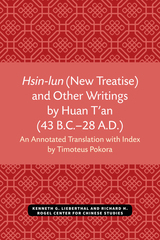 Hsin-lun (New Treatise) and Other Writings by Huan T'an (43 B.C.–28 A.D.)
An Annotated Translation with Index by Timoteus Pokora
University of Michigan Press, 1975 Better known in his own times than later, Huan T’an (43 BCE–25 CE) was a scholar-official, independent in his thought and unafraid to criticize orthodox currents of his time. A practitioner of the Old Text exegesis of the Classics, he maintained a position on the court during a turbulent time of political crises, uprisings, and civil war, spanning the reigns of four emperors. His principal work, Hsin-lun, differs from other books on political criticism in that it does not deal primarily with history but takes many examples from contemporary social and political life. While belonging to the Old Text group of court officials and scholars, Huan T’an differed radically from them in his stress on direct knowledge, in his range of practical experience, and in his outspoken criticism of popular opinions. He was not a systematic philosopher, but his ideas were influential in the return to a more worldly conception of Confucianism. To translate Huan T’an’s writings, one must reconstruct the texts. Timoteus Pokora uses two nineteenth-century fragments as a basis around which to orient quotations from Hsin-lun from sixty-four other sources, primarily encyclopedias and commentaries. Pokora provides notes to give context to these short references and to account for discrepancies between quotations and originals, and he includes a large index to add coherence and points of entry.
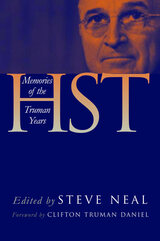 HST
Edited by Steve Neal. Foreword by Clifton Truman Daniel
Southern Illinois University Press, 2003 Believing that Americans should understand their leadership, Harry Truman was the first American president to authorize an oral history of his life and times. In that vein, almost forty years ago, the Truman Library in the president’s native Independence, Missouri, began the daunting task of compiling the words of Truman’s contemporaries, including his senior aides, foreign policy and military advisors, political strategists, and close friends. Longtime Chicago journalist Steve Neal has edited twenty of these remarkable interviews for HST: Memories of the Truman Years. Candid and insightful, the recollections include those of statesmen Dean Acheson and Averell Harriman; soldiers Omar Bradley and Lucius Clay; Truman’s best friend Thomas Evans; associates Clark Clifford and Matt Connelly; 1948 Republican vice-presidential nominee Earl Warren; artist Thomas Hart Benton; West German leader Konrad Adnauer; former New Dealers Sam Rosenman and James Rowe; journalist Richard L. Strout; and many others. An honest portrait of Truman emerges from the twenty firsthand accounts of those who knew him best. HST: Memories of the Truman Years spans Truman’s rise to the presidency and his responses to the challenges of World War II, the Soviet blockade of Berlin, the rebuilding of postwar Europe, the 1948 campaign, his controversial firing of General Douglas MacArthur, and his courageous leadership on civil rights. “The goal of these histories,” explains Truman’s grandson, Clifton Truman Daniel, in the foreword, “in keeping with Grandpa’s stated desire that the [Truman Library] be about his presidency, not a monument to him, was to preserve forever the perspective of those who had shared his life and times and, in many cases, helped him shape the world.”
Hu Shih and Intellectual Choice in Modern China
Min-Chih Chou
University of Michigan Press, 1984 Hu Shih and Intellectual Choice in Modern China sets out to analyze the life and thought of Hu Shih as a key to understanding China in his lifetime. The study focuses on the inner tensions and dimensions of Hu's life and attempts to reconstruct the intellectual and emotional dilemmas that his life encompassed. By describing Hu's pessimism and alienation aroused by an age of chaos, the study reveals what is meant to be a transitional figure in twentieth-century China. By extension, the book is a study of the tragedy of a Chinese cosmopolitan intellectual who could find no satisfying role in the life of his own turbulent nation.
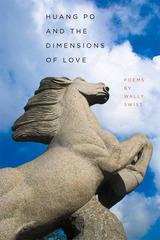 Huang Po and the Dimensions of Love
Wally Swist
Southern Illinois University Press, 2012 In Huang Po and the Dimensions of Love, poet Wally Swist blends themes of love and epiphany to lead readers into a more conscious interaction with the world around them. These ethereal poems call upon a spirituality unfettered to any specific religion, yet universal and potent in its scope, offering a window through which life can be not only viewed but also truly experienced. This luminescent collection illustrates the joys to be found in the everyday world and the power of existence. Unveiled here are the twin edges of love and madness; the quiet mysteries and revelations of a New England night or the glittering spark of snowdrops; the sharp scents of sugar maple and cinnamon; and the rustle of a junco’s wings. From the restoration and peace of silence or the rush of a brook, to spiraling hawks and Botticelli’s “The Annunciation,” Swist’s poems linger somewhere between the earthbound and the sublime.
 Huaorani Transformations in Twenty-First-Century Ecuador: Treks into the Future of Time
Laura Rival
University of Arizona Press, 2016 The indigenous people of the Amazon Basin known as the Huaorani are one of the world’s most intriguing peoples. The community of just under four thousand in Ecuador has been known to the public primarily for their historical identity as a violent society. But Laura Rival reveals the Huaorani in all their humanity and creativity through a longitudinal ethnography, bringing a deeper perspective beyond the stereotype.
Rival’s intimate knowledge of Huaorani culture spans twenty-five years. Here in a collection of broad-ranging essays, she offers a fascinating and provocative study. The first section, “Among Forest Beings,” shows that the Huaorani have long adapted to life in the tropical rain forest with minimal reliance on horticulture, yet have developed a complex relationship with plants. In “In the Longhouse,” the second section, Rival focuses on the intimate relations that create human persons and enact kinship relations. She also discusses women’s lives and perspectives. The third section, “In the Midst of Enemies,” considers how Huaorani society fits in larger political and economic contexts, illustrating how native values shape their encounters with oil companies, the state, and other external forces. Rival carefully analyzes insider/outsider dialectics wherein Huaorani people re-create meaningful and valued worlds in the face of alien projects, such as petroleum development, carbon trading, or intercultural education.
Capitalizing on the author’s decades-long study and interactions in the community, Huaorani Transformations in Twenty-First-Century Ecuador brings new insights to the Huaorani’s unique way of relating to humans, to other-than-humans, and to the forest landscape they have inhabited for centuries.
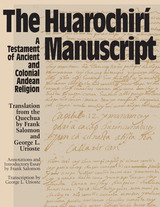 The Huarochiri Manuscript: A Testament of Ancient and Colonial Andean Religion
Translation from the Quechua by Frank Salomon and George L. Urioste
University of Texas Press, 1991 One of the great repositories of a people's world view and religious beliefs, the Huarochirí Manuscript may bear comparison with such civilization-defining works as Gilgamesh, the Popul Vuh, and the Sagas. This translation by Frank Salomon and George L. Urioste marks the first time the Huarochirí Manuscript has been translated into English, making it available to English-speaking students of Andean culture and world mythology and religions. The Huarochirí Manuscript holds a summation of native Andean religious tradition and an image of the superhuman and human world as imagined around A.D. 1600. The tellers were provincial Indians dwelling on the west Andean slopes near Lima, Peru, aware of the Incas but rooted in peasant, rather than imperial, culture. The manuscript is thought to have been compiled at the behest of Father Francisco de Avila, the notorious "extirpator of idolatries." Yet it expresses Andean religious ideas largely from within Andean categories of thought, making it an unparalleled source for the prehispanic and early colonial myths, ritual practices, and historic self-image of the native Andeans. Prepared especially for the general reader, this edition of the Huarochirí Manuscript contains an introduction, index, and notes designed to help the novice understand the culture and history of the Huarochirí-area society. For the benefit of specialist readers, the Quechua text is also supplied.
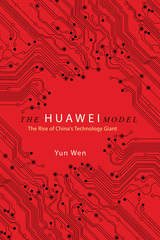 The Huawei Model: The Rise of China's Technology Giant
Yun Wen
University of Illinois Press, 2020 In 2019, the United States' trade war with China expanded to blacklist the Chinese tech titan Huawei Technologies Co. Ltd. The resulting attention showed the information and communications technology (ICT) firm entwined with China's political-economic transformation. But the question remained: why does Huawei matter? Yun Wen uses the Huawei story as a microcosm to understand China's evolving digital economy and the global rise of the nation's corporate power. Rejecting the idea of the transnational corporation as a static institution, she explains Huawei's formation and restructuring as a historical process replete with contradictions and complex consequences. She places Huawei within the international political economic framework to capture the dynamics of power structure and social relations underlying corporate China's globalization. As she explores the contradictions of Huawei's development, she also shows the ICT firm's complicated interactions with other political-economic forces. Comprehensive and timely, The Huawei Model offers an essential analysis of China's dynamic development of digital economy and the global technology powerhouse at its core.
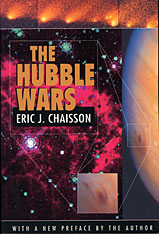 The Hubble Wars: Astrophysics Meets Astropolitics in the Two-Billion-Dollar Struggle over the Hubble Space Telescope, With a New Preface
Eric J. Chaisson
Harvard University Press, 1998 The Hubble Space Telescope is the largest, most complex, and most powerful observatory ever deployed in space, designed to allow astronomers to look far back into our own cosmic past with unprecedented clarity. Yet from its launch in 1990, when it was discovered that a flawed mirror was causing severe “myopia” and sending fuzzy images back to Earth, the HST has been at the center of a controversy over who was at fault for the flaw and how it should be fixed. Now Eric Chaisson, a former senior scientist on the HST project, tells the inside story of the much heralded mission to fix the telescope. Drawing on his journals, Chaisson recreates the day-to-day struggles of scientists, politicians, and publicists to fix the telescope and control the political spin. Illustrated with “before and after” full-color pictures from the telescope and updated with a new preface, The Hubble Wars tells an engaging tale of scientific comedy and error.
In this new edition, coming at the half-way point in the HST’s planned mission of fifteen years, Chaisson has brought the Hubble story up-to-date by sorting out the spectacular from the mundane contributions the HST has made to our knowledge of the Solar System, the Milky Way Galaxy, and the distant galaxies of deep space.
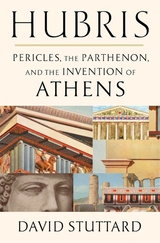 Hubris: Pericles, the Parthenon, and the Invention of Athens
David Stuttard
Harvard University Press A new perspective on ancient Athens at the height of its powers, reinterpreting the city’s supposed “Golden Age” as a period of ruinous culture wars.
The age of Pericles, in the fifth century BC, is often described as the Golden Age of Athens. The city witnessed a flowering of philosophy, art, and architecture—including an ambitious building program, with the Parthenon its centerpiece. But as David Stuttard shows in this vivid account, the seemingly triumphant city was in fact riven by conflict and contradiction. Though nominally a democracy, Athens led a tyrannical empire. And for Pericles and his circle, the Parthenon was less a holy place than a propaganda vehicle. Its sculptures carried the message that Athenians, beloved by the gods, were nearly divine in their own right—which to many Greeks smacked of hubris.
As long as things went well, Athenian democracy appeared to prosper. But just a year after the Parthenon was finished, Athens was at war with Sparta; a plague killed a third of the population, including Pericles; and earthquakes razed much of the city. In the wake of what seemed like divine retribution, popular outrage against those accused of undermining state religion was so strong that it took the execution of Socrates to lance the boil.
Hubris offers dramatic portraits of key figures like Pheidias, who sculpted the monumental statue of Athena yet fell prey to charges of impiety; Themistocles, who built the Athenian navy but died an exile in enemy lands; and Alcibiades, the psychopathic playboy whose mercurial ego hastened his city’s defeat. To understand the Parthenon and the Athens that built it, Stuttard makes clear, we must recognize the tensions among the city’s rivalrous families, generations, and social classes, whose visions of their place in the world ultimately proved incompatible.
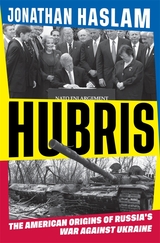 Hubris: The American Origins of Russia's War against Ukraine
Jonathan Haslam
Harvard University Press, 2025 A leading expert on US-Russian relations reveals how the United States and its European allies set the course for the war in Ukraine—and offers a sobering indictment of American foreign policy since the fall of the Soviet Union.
Russia’s full-scale invasion of Ukraine in February 2022 should not have taken the world by surprise. The attack escalated a war that began in 2014 with the Russian annexation of Crimea, but its origins are visible as far back as the aftermath of the Cold War, when newly independent Ukraine moved to the center of tense negotiations between Russia and the West. The United States was a leading player in this drama. In fact, Jonathan Haslam argues, it was decades of US foreign policy missteps and miscalculations, unchecked and often reinforced by European allies, that laid the groundwork for the current war.
Isolated, impoverished, and relegated to a second-order power on the world stage, Russia grew increasingly resentful of Western triumphalism in the wake of the Cold War. The United States further provoked Russian ire with a campaign to expand NATO into Eastern Europe—especially Ukraine, the most geopolitically important of the former Soviet republics. Determined to extend its global dominance, the United States repeatedly ignored signs that antagonizing Russia would bring consequences. Meanwhile, convinced that Ukraine was passing into the Western sphere of influence, Putin prepared to shift the European balance of power in Russia’s favor.
Timely and incisive, Hubris reveals the assumptions, equivocations, and grievances that have defined the West’s relations with Russia since the twilight of the Soviet Union—and ensured that collision was only a matter of time.
 Huckleberry Finn as Idol and Target: The Functions of Criticism in Our Time
Jonathan Arac
University of Wisconsin Press, 1997 If racially offensive epithets are banned on CNN air time and in the pages of USA Today, Jonathan Arac asks, shouldn’t a fair hearing be given to those who protest their use in an eighth-grade classroom? Placing Mark Twain’s comic masterpiece, Huckleberry Finn, in the context of long-standing American debates about race and culture, Jonathan Arac has written a work of scholarship in the service of citizenship.
Huckleberry Finn, Arac points out, is America’s most beloved book, assigned in schools more than any other work because it is considered both the “quintessential American novel” and “an important weapon against racism.” But when some parents, students, and teachers have condemned the book’s repeated use of the word “nigger,” their protests have been vehemently and often snidely countered by cultural authorities, whether in the universities or in the New York Times and the Washington Post. The paradoxical result, Arac contends, is to reinforce racist structures in our society and to make a sacred text of an important book that deserves thoughtful reading and criticism. Arac does not want to ban Huckleberry Finn, but to provide a context for fairer, fuller, and better-informed debates.
Arac shows how, as the Cold War began and the Civil Rights movement took hold, the American critics Lionel Trilling, Henry Nash Smith, and Leo Marx transformed the public image of Twain’s novel from a popular “boy’s book” to a central document of American culture. Huck’s feelings of brotherhood with the slave Jim, it was implied, represented all that was right and good in American culture and democracy. Drawing on writings by novelists, literary scholars, journalists, and historians, Arac revisits the era of the novel’s setting in the 1840s, the period in the 1880s when Twain wrote and published the book, and the post–World War II era, to refute many deeply entrenched assumptions about Huckleberry Finn and its place in cultural history, both nationally and globally. Encompassing discussion of Harriet Beecher Stowe, Frederick Douglass, Ralph Ellison, Archie Bunker, James Baldwin, Shelley Fisher Fishkin, and Mark Fuhrman, Arac’s book is trenchant, lucid, and timely.
 Huck’s Raft: A History of American Childhood
Steven Mintz
Harvard University Press, 2006 Like Huck’s raft, the experience of American childhood has been both adventurous and terrifying. For more than three centuries, adults have agonized over raising children while children have followed their own paths to development and expression. Now, Steven Mintz gives us the first comprehensive history of American childhood encompassing both the child’s and the adult’s tumultuous early years of life.
Underscoring diversity through time and across regions, Mintz traces the transformation of children from the sinful creatures perceived by Puritans to the productive workers of nineteenth-century farms and factories, from the cosseted cherubs of the Victorian era to the confident consumers of our own. He explores their role in revolutionary upheaval, westward expansion, industrial growth, wartime mobilization, and the modern welfare state. Revealing the harsh realities of children’s lives through history—the rigors of physical labor, the fear of chronic ailments, the heartbreak of premature death—he also acknowledges the freedom children once possessed to discover their world as well as themselves.
Whether at work or play, at home or school, the transition from childhood to adulthood has required generations of Americans to tackle tremendously difficult challenges. Today, adults impose ever-increasing demands on the young for self-discipline, cognitive development, and academic achievement, even as the influence of the mass media and consumer culture has grown. With a nod to the past, Mintz revisits an alternative to the goal-driven realities of contemporary childhood. An odyssey of psychological self-discovery and growth, this book suggests a vision of childhood that embraces risk and freedom—like the daring adventure on Huck’s raft.
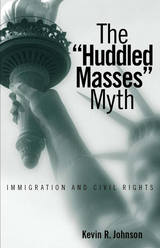 The Huddled Masses Myth: Immigration And Civil Rights
Kevin R. Johnson
Temple University Press, 2003 Despite rhetoric that suggests that the United States opens its doors to virtually anyone who wants to come here, immigration has been restricted since the nation began. In this book, Kevin R. Johnson argues that immigration policy reflects the social hierarchy that prevails in American society as a whole and that immigration reform is intertwined with the struggle for civil rights. The "Huddled Masses" Myth focuses on the exclusion of people of color, gays and lesbians, people with disabilities, the poor, political dissidents, and other disfavored groups, showing how bias shapes the law. In the nineteenth century, for example, virulent anti-Asian bias excluded would-be immigrants from China and severely restricted those from Japan. In our own time, people fleeing persecution and poverty in Haiti generally have been treated much differently from those fleeing Cuba. Johnson further argues that although domestic minorities (whether citizens or lawful immigrants) enjoy legal protections and might even be courted by politicians, they are regarded as subordinate groups and suffer discrimination. This book has particular resonance today as the public debates the uncertain status of immigrants from Arab countries and of the Muslim faith.
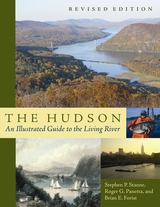 The Hudson: An Illustrated Guide to the Living River
Stanne, Stephen P
Rutgers University Press, 2007
The Hudson River is one of the great rivers of the world. Not long ago, it was deeply threatened by pollution. Now it is coming back to life, a river where fish and birds can thrive again, a river valued once more by communities along its shores.
The unique environmental education program on board the sloop, Clearwater, founded by folksinger Pete Seeger, has taught thousands of children and adults to love the river. With this guidebook, Clearwater teachers bring their wealth of knowledge about the river to a wider audience.
This book covers, for the first time, the full sweep of the river's natural history and human heritage. It introduces you to the Hudson's diversity of plants and wildlife, to the geological forces that created the river, to the people who explored and settled its banks, to the river's enduring place in American history and art, and to the battles waged over its environmental preservation. Its engaging illustrations, maps, and text––distilled from the best research on the Hudson's habitat and history––invite you to explore the river yourself.
Royalties from the sale of this book will support the continued restoration of the river's ecological well-being through the programs of the Hudson River Sloop Clearwater, Inc., a nonprofit education and advocacy organization based in Poughkeepsie, New York.
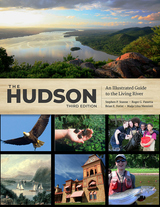 The Hudson: An Illustrated Guide to the Living River
Stephen P. Stanne
Rutgers University Press, 2021 Since 1996, The Hudson: An Illustrated Guide to the Living River has been an essential resource for understanding the full sweep of the great river's natural history and human heritage. This updated third edition includes the latest information about the ongoing fight against pollution and environmental damage to the river, plus vibrant new full-color illustrations showing the plants and wildlife that make this ecosystem so special.
This volume gives a detailed account of the Hudson River’s history, including the geological forces that created it, the various peoples who have lived on its banks, and the great works of art it has inspired. It also showcases the many species making a home on this waterway, including the Atlantic sturgeon, the bald eagle, the invasive zebra mussel, and the herons of New York Harbor. Combining both scientific and historical perspectives, this book demonstrates why the Hudson and its valley have been so central to the environmental movement.
As it charts the progress made towards restoring the river ecosystem and the effects of emerging threats like climate change, The Hudson identifies concrete ways that readers can help. To that end, royalties from the sale of this book will go to the non-profit environmental advocacy group Hudson River Sloop Clearwater, Inc.
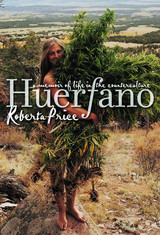 Huerfano: A Memoir of Life in the Counterculture
Roberta M. Price
University of Massachusetts Press, 2004 In the late 1960s, new age communes began springing up in the American Southwest with names like Drop City, New Buffalo, Lama Foundation, Morning Star, Reality Construction Company, and the Hog Farm. In the summer of 1969, Roberta Price, a recent college graduate, secured a grant to visit these communities and photograph them. When she and her lover David arrived at Libre in the Huerfano Valley of southern Colorado, they were so taken with what they found that they wanted to participate instead of observe. The following spring they married, dropped out of graduate school in upstate New York, packed their belongings into a 1947 Chrysler Windsor Coupe, and moved to Libre, leaving family and academia behind.
Huerfano is Price's captivating memoir of the seven years she spent in the Huerfano ("Orphan") Valley when it was a petrie dish of countercultural experiments. She and David joined with fellow baby boomers in learning to mix cement, strip logs, weave rugs, tan leather, grow marijuana, build houses, fix cars, give birth, and make cheese, beer, and furniture as well as poetry, art, music, and love. They built a house around a boulder high on a ridge overlooking the valley and made ends meet by growing their own food, selling homemade goods, and hiring themselves out as day laborers. Over time their collective ranks swelled to more than three hundred, only to diminish again as, for many participants, the dream of a life of unbridled possibility gradually yielded to the hard realities of a life of voluntary poverty.
Price tells her story with a clear, distinctive voice, documenting her experiences with photos as well as words. Placing her story in the larger context of the times, she describes her participation in the antiwar movement, the advent of the women's movement, and her encounters with such icons as Ken Kesey, Gary Snyder, Abbie Hoffman, Stewart Brand, Allen Ginsburg, and Baba Ram Dass.
At once comic, poignant, and above all honest, Huerfano recaptures the sense of affirmation and experimentation that fueled the counterculture without lapsing into nostalgic sentimentality on the one hand or cynicism on the other.
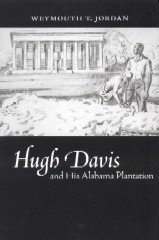 Hugh Davis and His Alabama Plantation
Weymouth T. Jordan
University of Alabama Press, 1948 Hugh Davis and His Alabama Plantation provides a detailed account of the founding, management, and finances of a Southern Antebellum plantation. After practicing law in Marion, Alabama for 14 years, Hugh Davis became a cotton planter in 1848 at Beaver Bend, where he brought 5,000 acres of Blackbelt land on the Cahaba River under cultivation and partook of the last decade of hubristic wealth before the coming of the Civil War.
Scholars and readers continue to illuminate the complex financial arrangements of the Antebellum South, many regions of which lacked basic banking services. Following the life of Davis traces his early years of apprenticeship and debt, the use of rotating credit, and the relationship of slaves to finances. The book is also full of fascinating details of his life, such as the setting out in one month of 750 yards of roses. This account also recounts the how this financial system and lifestyle were swept away by the Civil War.
Scholars and general readers interested in Southern history as illuminated not in macroeconomic theories but in the quotidian life and choices of one man will find much of interest in Davis's life.
A Hugh Henry Brackenridge Reader, 1770-1815
Daniel Marder
University of Pittsburgh Press, 1970 A collection of the work of Hugh Henry Brackenridge (1748-1816)-one of the most vigorous and prolific writers of his time. An ardent believer in an educated public, his efforts to implant the ideals of democracy in early America made him a legend on the frontier. This selection of his work captures the essence of the man and his time, and includes writing published in the United States Magazine, Pittsburgh Gazette, as well as his narrative on the Whiskey Rebellion, Incidents of the Insurrection.
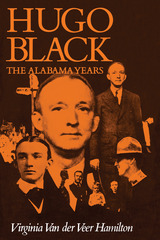 Hugo Black: The Alabama Years
Virginia Van der Veer Hamilton
University of Alabama Press, 1982 A political biography, probing the labyrinth of Alabama politics in an effort to discover what forces, other than his own, shaped Hugo Black and set him upon the road to the Court
Almost any Alabamian, white or black, unsophisticated or meagerly educated, can name one man who was a justice of the United States Supreme Court. That name may be spoken with praise or, more often, profanity, but Hugo La Fayette Black, who left Alabama for Washington in 1927, remained a presence of major, almost legendary, proportions in his native state of Alabama. He was an associate justice of the Supreme Court for so many years that most Alabamians were vague as to what he did before and how he got the job. But any gray-haired man of seventy or eighty on Twentieth Street in Birmingham will tell you quickly enough that Hugo Black, beginning in the now-dim era of the Coolidge administration,. was once United States senator.
Hugo Chavez: Socialist for the Twenty-first Century
Mike Gonzalez
Pluto Press, 2014 When Hugo Chavez, then President of Venezuela, died in 2013, millions across the globe mourned. In an age where most politicians inspire only apathy and cynicism, Chavez's popularity, radicalism and vibrant personality were truly unique.
Released one year after Chavez's unexpected death, this dramatic and intimate biography traces Chavez's life from an impoverished rural family to the Miraflores Presidential Palace in Caracas. Mike Gonzalez shows how Chavez's 'Bolivarian revolution' aimed to complete Simon Bolivar’s promise of a Latin America free from imperialism.
Gonzalez details Chavez's close connection to the masses and how he enraged wealthy elites by declaring his support for 21st century socialism. He concludes that the struggle for social justice inspired by Chavez can and must continue. This is an ideal guide to Chavez's inspiring life and legacy.
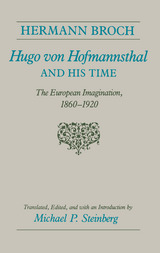 Hugo von Hofmannsthal and His Time: The European Imagination, 1860-1920
Hermann Broch
University of Chicago Press, 1984 Hermann Broch (1886-1951) is remembered among English-speaking readers for his novels The Sleepwalkers and The Death of Virgil, and among German-speaking readers for his novels as well as his works on moral and political philosophy, his aesthetic theory, and his varied criticism. This study reveals Broch as a major historian as well, one who believes that true historical understanding requires the faculties of both poet and philosopher.
Through an analysis of the changing thought and career of the Austrian poet, librettist, and essaist Hugo von Hofmannsthal (1874-1929), Broch attempts to define and analyze the major intellectual issues of the European fin de siècle, a period that he characterizes according to the Nietzschean concepts of the breakdown of rationality and the loss of a central value system. The result is a major examination of European thought as well as a comparative study of political systems and artistic styles.
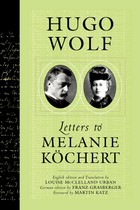 Hugo Wolf: Letters To Melanie Kochert
Hugo Wolf
University of Wisconsin Press, 2003 This is a love story. It tells of an extraordinary epistolary relationship between Hugo Wolf, one of the greatest masters of the German art song, whose dedication to the poetic spirit of his music was equaled only by Franz Schubert and Robert Schumann, and Melanie Köchert, the wife of a prominent Viennese jeweler with whom Wolf shared a lifelong emotional, spiritual, and artistic bond.
Wolf’s letters to Köchert—he wrote 245 between 1887 and 1899—were composed during a period of almost unprecedented cultural upheaval in Europe, in the shadow of Vienna during the era of Freud, Mahler, and Klimt. They reveal Wolf at his most optimistic, celebrating his concert successes and the solitude he believed was so precious to his ability to compose. They follow Wolf through times of overwhelming despair, when his musical failures left him profoundly alienated, overcome, as he revealed to Köchert, "by a feeling of unspeakable emptiness and desolation." And they follow Wolf as he struggled to compose the 250 astounding art songs that are his creative legacy, and his almost simultaneous descent into madness.
Hugo Wolf: Letters to Melanie Köchert, sensitively translated by Wolf scholar and interpreter Louise McClelland Urban, is a literary and musical even of the highest order
Huguccio: The Life, Works, and Thought of a Twelfth-Century Jurist
Wolfgang Muller
Catholic University of America Press, 1994 Huguccio was an important lawyer of the medieval church, bishop of Ferrara, and one of the greatest representatives of twelfth-century scholasticism. In this book-length study of this influential figure, Wolfgang P. Müller provides a critical account of the biographical information on the man and his writings. He discusses the various aspects of Huguccio's career and thought as well as the manuscript tradition of some of his works. The author's scholarship rests on direct consultation and painstaking analysis of enormous quantities of manuscript material.
This book provides the point of departure for anyone wishing to study Huguccio first-hand. It will be worthy reading for students of medieval canon law and an essential addition to all libraries supporting research in medieval studies.
The Huguenot Experience of Persecution and Exile: Three Women’s Stories
Charlotte Arbaleste Duplessis-Mornay, Anne de Chaufepié, and Anne Marguerite Petit Du Noyer
Iter Press, 2019 This volume provides an English translation of firsthand testimonies by three early modern French women. It illustrates the Huguenot experience of persecution and exile during the bloodiest times in the history of Protestantism: the St. Bartholomew’s Day Massacre, the dragonnades, and the Huguenot exodus following the Revocation of the Edict of Nantes. The selections given here feature these women’s experiences of escape, the effects of religious strife on their families, and their reliance on other women amid the terrors of war.
Edited by Colette H. Winn. Translated by Lauren King and Colette H. Winn
The Other Voice in Early Modern Europe: The Toronto Series, Vol. 68
The Huguenots in America: A Refugee People in New World Society
Jon Butler
Harvard University Press, 1983 In the first modern history of the Huguenots’ New World experience, Jon Butler traces the Huguenot diaspora across late seventeenth-century Europe, explores the causes and character of their American emigration, and reveals the Huguenots’ secular and religious assimilation in three remarkably different societies: Boston, New York, and South Carolina.
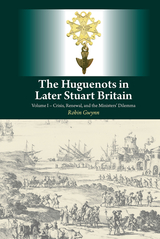 The Huguenots in Later Stuart Britain, Vol. 1: Crisis, Renewal and the Ministers' Dilemma
Robin Gwynn
Sussex Academic Press, 2022 The Huguenots in Later Stuart Britain is planned as one work to be published in three interlinking volumes (titles/publication dates detailed below). It examines the history of the French communities in Britain from the Civil War, which plunged them into turmoil, to the Treaty of Utrecht in 1713, after which there was no realistic possibility that the Huguenots would be readmitted to France. There is a particular focus on the decades of the 1680s and 1690s, at once the most complex, the most crucial, and the most challenging alike for the refugees themselves and for subsequent historians. The work opens with the Calvinist French-speaking communities in England caught up in the Civil War. They could not avoid it, with many of their members largely assimilated into English society by the 1640s. Generally they favoured the Parliamentarian side, but any victory was pyrrhic because the Interregnum supported the rights of Independent congregations which undermined their whole Calvinist structure. Weakened by in-fighting, in the 1660s the old-established French churches then had to reassert their right to exist in the face of a sometimes hostile restored monarchy and episcopacy, a newly licenced French church emphasizing its Anglicanism and its loyalty to the crown, and the challenges of the Plague and the Fire of London which burnt the largest French church in England to the ground. They were still staggering to find their feet when the first trickle and then the full flood of new Huguenot immigration overwhelmed them. As for the newly arriving Huguenot ministers, not prepared for the England to which they came, they found they had to resolve what was often an intense personal dilemma: should they stand fast for the worship they had led in France, or accept Anglican ways? - and if they did accept Anglicanism, to what extent? It is demonstrated that many ministers took the Anglican route, although Volume II will show that the French communities as a whole, old and new alike, voted with their feet not to do so. A substantial appendix provides a biographical account of over 600 ministers in the orbit of the French churches across this period. Volume II: Settlement, Churches, and the Role of London - 978-1-84519-619-6 (2017); Volume III: The Huguenots and the Defeat of Louis XIV's France - 978-1-84519-620-2 (2020).
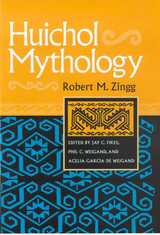 Huichol Mythology
Robert M. Zingg; Edited by Jay C. Fikes, Phil C. Weigand, and Acelia García de Weigand
University of Arizona Press, 2004 Best known for their ritual use of peyote, the Huichol people of west-central Mexico carried much of their original belief system into the twentieth century unadulterated by the influence of Christian missionaries. Among the Huichol, reciting myths and performing rituals pleases the ancestors and helps maintain a world in which abundant subsistence and good health are assured. This volume is a collection of myths recorded by Robert Zingg in 1934 in the village of Tuxpan and is the most comprehensive record of Huichol mythology ever published.
Zingg was the first professional anthropologist to study the Huichol, and his generosity toward them and political advocacy on their behalf allowed him to overcome tribal sanctions against divulging secrets to outsiders. He is fondly remembered today by some Huichols who were children when he lived among them. Zingg recognized that the alternation between dry and wet seasons pervades Huichol myth and ritual as it does their subsistence activities, and his arrangement of the texts sheds much light on Huichol tradition. The volume contains both aboriginal myths that attest to the abiding Huichol obligation to serve ancestors who control nature and its processes, and Christian-inspired myths that document the traumatic effect that silver mining and Franciscan missions had on Huichol society.
First published in 1998 in a Spanish-language edition, Huichol Mythology is presented here for the first time in English, with more than 40 original photographs by Zingg accompanying the text. For this volume, the editors provide a meticulous historical account of Huichol society from about 200 A.D. through the colonial era, enabling readers to fully grasp the significance of the myths free of the sensationalized interpretations found in popular accounts of the Huichol. Zingg’s compilation is a landmark work, indispensable to the study of mythology, Mexican Indians, and comparative religion.
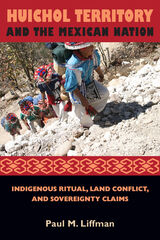 Huichol Territory and the Mexican Nation: Indigenous Ritual, Land Conflict, and Sovereignty Claims
Paul M. Liffman
University of Arizona Press, 2011 The Huichol (Wixarika) people claim a vast expanse of Mexico’s western Sierra Madre and northern highlands as a territory called kiekari, which includes parts of the states of Nayarit, Jalisco, Durango, Zacatecas, and San Luis Potosí. This territory forms the heart of their economic and spiritual lives. But indigenous land struggle is a central fact of Mexican history, and in this fascinating new work Paul Liffman expands our understanding of it. Drawing on contemporary anthropological theory, he explains how Huichols assert their sovereign rights to collectively own the 1,500 square miles they inhabit and to practice rituals across the 35,000 square miles where their access is challenged. Liffman places current access claims in historical perspective, tracing Huichol communities’ long-term efforts to redress the inequitable access to land and other resources that their neighbors and the state have imposed on them.
Liffman writes that “the cultural grounds for territorial claims were what the people I wanted to study wanted me to work on.” Based on six years of collaboration with a land-rights organization, interviews, and participant observation in meetings, ceremonies, and extended stays on remote rancherías, Huichol Territory and the Mexican Nation analyzes the sites where people define Huichol territory. The book’s innovative structure echoes Huichols’ own approach to knowledge and examines the nation and state, not just the community. Liffman’s local, regional, and national perspective informs every chapter and expands the toolkit for researchers working with indigenous communities. By describing Huichols’ ceremonially based placemaking to build a theory of “historical territoriality,” he raises provocative questions about what “place” means for native peoples worldwide.
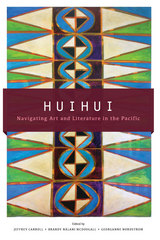 Huihui: Navigating Art and Literature in the Pacific
edited by Jeffrey Carroll, Brandy McDougall, and Georganne Nordstrom
University of Hawaii Press, 2014 This groundbreaking anthology is the first to navigate the interconnections between the rhetorics and aesthetics of the Pacific. Like the bright and multifaceted constellation for which it is named, Huihui: Rhetorics and Aesthetics in the Pacific showcases a variety of genres and cross-genre forms—critical essays, poetry, short fiction, speeches, photography, and personal reflections—that explore a wide range of subjects, from Disney’s Aulani Resort to the Bishop Museum, from tiki souvenirs to the Dusky Maiden stereotype, from military recruitment to colonial silencing, from healing lands to healing words and music, from decolonization to sovereignty.
These works go beyond conceiving of Pacific rhetorics and aesthetics as being always and only in response to a colonizing West and/or East. Instead, the authors emphasize the importance of situating their work within indigenous intellectual, political, and cultural traditions and innovations of the Pacific. Taken together, this anthology threads ancestral and contemporary discursive strategies, questions colonial and oppressive representations, and seeks to articulate an empowering decolonized future for all of Oceania.
Representing several island and continental nations, the contributing authors include Albert Wendt, Haunani-Kay Trask, Mililani Trask, Chantal Spitz, Jonathan Kay Kamakawiwoʻole Osorio, Flora Devatine, Kalena Silva, Steven Winduo, Alice Te Punga Somerville, Selina Tusitala Marsh, kuʻualoha hoʻomanawanui, Craig Santos Perez, Gregory Clark, Chelle Pahinui, Dan Taulapapa McMullin, Michael Puleloa, Lisa King, and Steven Gin. Collectively, their words guide us over ocean routes like the great waʻa, vaʻa, waka, proa, and sakman once navigated by the ancestors of Oceania, now navigated again by their descendants.
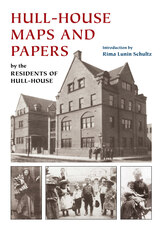 Hull-House Maps and Papers: A Presentation of Nationalities and Wages in a Congested District of Chicago, Together with Comments and Essays on Problems Growing Out of the Social Conditions
By the Residents of Hull-House
University of Illinois Press, 2007 Inspired by their Progressive Era faith in social science solutions to society’s problems, the residents of Hull-House collaborated on this work of sociology based on their experiences as residents of Chicago’s Near West Side. The contributors to this book believed that an enlightened citizenry could be mobilized for reform, and that by publishing maps with explicit information about the wages and conditions of the working poor in Chicago’s Nineteenth Ward they would educate the public and inspire reforms. In addition to Jane Addams’s own prefatory note and paper on the role of social settlements in the labor movement, contributors provided detailed, real-world analyses of the Chicago Jewish ghetto, garment workers and the sweatshops, child labor, immigrant neighborhoods in the vicinity of Hull-House, and local charities. This edition also contains eight color reproductions of the original Hull-House neighborhood maps. The year 2006 marks the one hundred and eleventh anniversary of the publication of Hull-House Maps and Papers, and the volume remains a dramatic statement about the residents’ shared values as well as a major influence on subsequent social surveys.
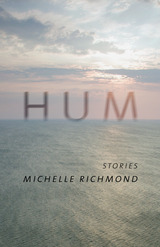 Hum: Stories
Michelle Richmond
University of Alabama Press, 2014 A new collection of stories by bestselling author Michelle Richmond, Hum presents a cautionary political fable, a celebration of the complexities of marriage, and a meditation on modern-day alienation.
Thirteen years after the publication of her first story collection, The Girl in the Fall-Away Dress, New York Times bestselling author Michelle Richmond returns with Hum, a collection of ten stories that examine love, lust, and loyalty from surprising angles.
In “Hum,” a young couple that is paid to live in a house filled with surveillance equipment becomes “quietly lost to each other,” as the wife’s infatuation with the subject of their surveillance turns to obsession. In “Medicine,” a woman grieving over the death of her sister finds her calling as a manual medical caregiver. In “Boulevard,” a couple who has been trying to have a child for seven years finds themselves in an unnamed country at the height of a revolution, summoned there by the enigmatic H. “Scales,” the story of a woman who falls in love with a man whose body is covered with scales, parses the intersection of pain and pleasure. The narrator of “Lake” must choose whether to walk in the footsteps of her famous grandfather, The Great Amphibian, who disappeared while performing a feat of daring in Lake Michigan. What does it mean to be heroic? How much should one sacrifice in the name of love? These questions and more are explored with tenderness, wit, and unerring precision in Hum.
Human Action in Thomas Aquinas, John Duns Scotus, and William of Ockham
Thomas M. Osborne Jr.
Catholic University of America Press, 2014 This book sets out a thematic presentation of human action, especially as it relates to morality, in the three most significant figures in Medieval Scholastic thought: Thomas Aquinas, John Duns Scotus, and William of Ockham
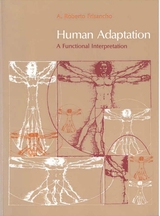 Human Adaptation and Accommodation
A. Roberto Frisancho
University of Michigan Press, 1993 How human beings have adapted to a wide range of stressful environments – extreme temperatures, solar radiation, high altitudes, and nutritional stress – has been the subject of much research in recent years by psychologists, biologists, and physical anthropologists. Here for the first time Dr. Frisancho presents in a single volume knowledge on human adaptation that has previously been widely scattered and highly specialized. He examines from physiological and anthropological perspectives the short- and long-term reactions of the human body to various environmental stresses. Based on research that has been done in the laboratory and from studies of native populations living in stressful environments, Dr. Frisancho discusses the effects of extreme heat and cold, solar radiation and the selective value of skin pigmentation, high altitude hypoxia, growth in high altitude populations, diseases related to life in high altitudes, diseases and effects of undernourishment, and disease and the westernization of diet. This work is a valuable and much needed introduction to the field of human adaptation.
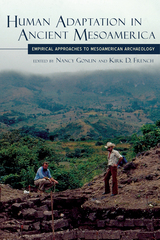 Human Adaptation in Ancient Mesoamerica: Empirical Approaches to Mesoamerican Archaeology
Nancy Gonlin
University Press of Colorado, 2016 This volume explores the dynamics of human adaptation to social, political, ideological, economic, and environmental factors in Mesoamerica and includes a wide array of topics, such as the hydrological engineering behind Teotihuacan’s layout, the complexities of agriculture and sustainability in the Maya lowlands, and the nuanced history of abandonment among different lineages and households in Maya centers. The authors aptly demonstrate how culture is the mechanism that allows people to adapt to a changing world, and they address how ecological factors, particularly land and water, intersect with nonmaterial and material manifestations of cultural complexity. Contributors further illustrate the continuing utility of the cultural ecological perspective in framing research on adaptations of ancient civilizations. This book celebrates the work of Dr. David Webster, an influential Penn State archaeologist and anthropologist of the Maya region, and highlights human adaptation in Mesoamerica through the scientific lenses of anthropological archaeology and cultural ecology.
Contributors include Elliot M. Abrams, Christopher J. Duffy, Susan Toby Evans, Kirk D. French, AnnCorinne Freter, Nancy Gonlin, George R. Milner, Zachary Nelson, Deborah L. Nichols, David M. Reed, Don S. Rice, Prudence M. Rice, Rebecca Storey, Kirk Damon Straight, David Webster, Stephen L. Whittington, Randolph J. Widmer, John D. Wingard, and W. Scott Zeleznik.
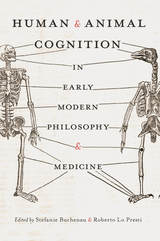 Human and Animal Cognition in Early Modern Philosophy and Medicine
Stefanie Buchenau
University of Pittsburgh Press, 2017 From the sixteenth to the eighteenth century, new anatomical investigations of the brain and the nervous system, together with a renewed interest in comparative anatomy, allowed doctors and philosophers to ground their theories on sense perception, the emergence of human intelligence, and the soul/body relationship in modern science. They investigated the anatomical structures and the physiological processes underlying the rise, differentiation, and articulation of human cognitive activities, and looked for the “anatomical roots” of the specificity of human intelligence when compared to other forms of animal sensibility.
This edited volume focuses on medical and philosophical debates on human intelligence and animal perception in the early modern age, providing fresh insights into the influence of medical discourse on the rise of modern philosophical anthropology. Contributions from distinguished historians of philosophy and medicine focus on sixteenth-century zoological, psychological, and embryological discourses on man; the impact of mechanism and comparative anatomy on philosophical conceptions of body and soul; and the key status of sensibility in the medical and philosophical enlightenment.
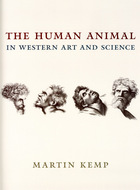 The Human Animal in Western Art and Science
Martin Kemp
University of Chicago Press, 2007 From the lazy, fiddling grasshopper to the sneaky Big Bad Wolf, children’s stories and fables enchant us with their portrayals of animals who act like people. But the comparisons run both ways, as metaphors, stories, and images—as well as scientific theories—throughout history remind us that humans often act like animals, and that the line separating them is not as clear as we’d like to pretend.
Here Martin Kemp explores a stunning range of images and ideas to demonstrate just how deeply these underappreciated links between humans and other fauna are embedded in our culture. Tracing those interconnections among art, science, and literature, Kemp leads us on a dazzling tour of Western thought, from Aristotelian physiognomy and its influence on phrenology to the Great Chain of Being and Darwinian evolution. We learn about the racist anthropology underlying a familiar Degas sculpture, see paintings of a remarkably simian Judas, and watch Mowgli, the man-child from Kipling’s The Jungle Book, exhibit the behaviors of the beasts who raised him. Like a kaleidoscope, Kemp uses these stories to refract, reconfigure, and echo the essential truth that the way we think about animals inevitably inflects how we think about people, and vice versa.
Loaded with vivid illustrations and drawing on sources from Hesiod to La Fontaine, Leonardo to P. T. Barnum, The Human Animal in Western Art and Science is a fascinating, eye-opening reminder of our deep affinities with our fellow members of the animal kingdom.
 Human Aspects of Biomedical Innovation
Everett Mendelsohn
Harvard University Press, 1971 The authors of these eight essays examine the social and ethical implications of new biomedical technologies—from behavior control to organ transplants and human experimentation. They also examine the shortcomings in our system of medical care—from the disappearance of the general practitioner to problems of medical care for the poor.
In an introductory essay, Irene Taviss analyzes the allocation of resources to biomedical research and medical care and considers problems related to human experimentation, organ transplantation, and genetic and behavior control. She also discusses possible controls in these fields—legal controls as well as formal professional codes and informal professional practices. In discussing the rare disease phenylketonuria, a cause of mental retardation, Samuel P. Bessman and Judith P. Swazey point out the dangers of a hasty decision to institute legislative controls of diseases on the basis of inadequate scientific evidence. In separate essays, Edmund D. Pellegrino and Louis Lasagna examine the problems of establishing professional controls over different kinds of human experimentation. Everett P. Mendelsohn, Judith P. Swazey, and Irene Taviss present an overview of the new behavior control technologies and point out the dilemmas that have resulted from these developments. Victor Sidel's essay examines the effects of new technologies on the practice of medicine and the potential effects on society. The two final essays deal with the organization and delivery of medical care. Mark G. Field reports on the problems caused by medical specialization and the disappearance of the general practitioner and proposes some remedies. John H. Knowles analyzes medical manpower shortages in various specialties and the effects of these shortages on the health care of the nation.
 Human: Babylonian Reflections on Labor
Sophus Helle
University of Chicago Press Acclaimed author and translator Sophus Helle considers an ancient creation story with themes of humanity, class warfare, and catastrophic climate change.
The Babylonian poem Atra-hasis is a forgotten masterpiece of political thought. Written in Akkadian in what is now southern Iraq during the early second millennium BCE, Atra-hasis gives us a glimpse of how ancient poets understood the society growing around them. This radical history of the world told from the perspective of the mother goddess conveys the complexity and contradictions that lie at the heart of the human experience. Atra-hasis tells how humanity was created as part of a bargain to resolve the world’s first labor strike, in which the lower gods rebelled against the excessive work imposed on them by the higher gods. It depicts humans as workers endowed with defiant intelligence. They multiply and become too loud, so the gods decide to quiet them with a cataclysmic flood.
Looking to Atra-hasis, Sophus Helle reveals an ancient story with reflections on power and history that invite comparison to topics of contemporary relevance, including labor, inequality, climate change, artificial intelligence, threats to democracy, disability, care work, sexual consent, and more. Helle considers Atra-hasis as a foundational document of “pasthumanism,” a term he uses to describe the study of how cultural conceptions of humanity have changed across centuries. He argues that ancient and non-Western texts remind us that cultural assumptions we now take for granted are neither natural nor necessary.
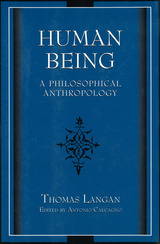 Human Being: A Philosophical Anthropology
Thomas Langan, Edited by Antonio Calcagno
University of Missouri Press, 2009 What is “human being”? In this book, Thomas Langan draws on a lifetime of study to offer a new understanding of this central question of our existence, turning to phenomenology and philosophical anthropology to help us better understand who we are as individuals and communities and what makes us act the way we do.
While recognizing the human being as an individual with a particular genetic makeup and history, Langan also probes the real essence of human being that philosophers have tended to ignore. He argues that human being is the result of the experiences of humans throughout time—an ontological reality that not only incorporates our collective memories, institutions, habits, ethical practices, and religious faiths but also unfolds in time with its own history to inform individuals in the present. He provides tools and descriptions for accessing this broader historical and present-day reality, investigating deeper structures of human being to show how those historical roots can be appropriated and made meaningful.
Building on Langan’s earlier works, Human Being is also readily accessible on its own. Langan shows how the larger issues discussed in those books, ranging from the Catholic tradition to high technology, relate to being human while he brings to light new philosophical insights and ideas.
Because human beings continue to evolve, informing our everyday understanding of the world, Langan shows how vital it is for us to think through the sense of human being and how great a challenge that is in today’s society. His work offers insight into human being that invites readers to think and live more deeply in their humanity—and to face the challenges of a rapidly changing world by reawakening perennial quests for love and the divine, and the very search for meaning itself.
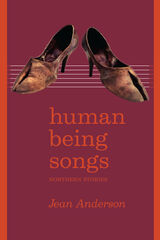 Human Being Songs: Northern Stories
Jean Anderson
University of Alaska Press, 2017 The public image of Alaska for those who live elsewhere tends to be bound up with the outdoors. But while that’s not necessarily false, it’s a far from complete picture. This collection of stories shows us what we’re missing: set in Alaska’s cities and suburbs, homes and back roads, cars and kitchens and bedrooms, it offers not tales of adventures, but quietly powerful psychological dramas, introspective explorations of the private triumphs and failures of personal life played out in an extraordinary place.
Jean Anderson delicately balances the lyrical and the experimental to tell the stories of hardworking Alaskans—teachers, laborers, dental hygienists, artists—worrying over fairness and equity and meaning, falling in and out of love, and pondering elusive, long-dreamed-of goals. Powered by a rich empathy, Human Being Songs shows us life in Alaska as it’s actually lived today—its successes, failures, and moments of transcendent beauty.
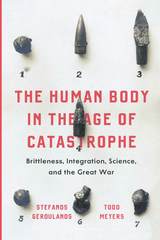 The Human Body in the Age of Catastrophe: Brittleness, Integration, Science, and the Great War
Stefanos Geroulanos and Todd Meyers
University of Chicago Press, 2018 The injuries suffered by soldiers during WWI were as varied as they were brutal. How could the human body suffer and often absorb such disparate traumas? Why might the same wound lead one soldier to die but allow another to recover?
In The Human Body in the Age of Catastrophe, Stefanos Geroulanos and Todd Meyers uncover a fascinating story of how medical scientists came to conceptualize the body as an integrated yet brittle whole. Responding to the harrowing experience of the Great War, the medical community sought conceptual frameworks to understand bodily shock, brain injury, and the vast differences in patient responses they occasioned. Geroulanos and Meyers carefully trace how this emerging constellation of ideas became essential for thinking about integration, individuality, fragility, and collapse far beyond medicine: in fields as diverse as anthropology, political economy, psychoanalysis, and cybernetics.
Moving effortlessly between the history of medicine and intellectual history, The Human Body in the Age of Catastrophe is an intriguing look into the conceptual underpinnings of the world the Great War ushered in.
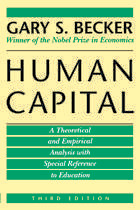 Human Capital: A Theoretical and Empirical Analysis, with Special Reference to Education, 3rd Edition
Gary S. Becker
University of Chicago Press, 1993 Human Capital is Becker's classic study of how investment in an individual's education and training is similar to business investments in equipment. Recipient of the 1992 Nobel Prize in Economic Science, Gary S. Becker is a pioneer of applying economic analysis to human behavior in such areas as discrimination, marriage, family relations, and education. Becker's research on human capital was considered by the Nobel committee to be his most noteworthy contribution to economics.
This expanded edition includes four new chapters, covering recent ideas about human capital, fertility and economic growth, the division of labor, economic considerations within the family, and inequality in earnings.
"Critics have charged that Mr. Becker's style of thinking reduces humans to economic entities. Nothing could be further from the truth. Mr. Becker gives people credit for having the power to reason and seek out their own best destiny."—Wall Street Journal
 Human Capital for Humans: An Accessible Introduction to the Economic Science of People
Pablo A. Peña
University of Chicago Press, 2025 An accessible introduction to the most consequential science of modern life.
University of Chicago economist Gary Becker won the Nobel Prize largely for his advancement of human capital theory—the idea that investing in a person’s knowledge and skills has a wide range of economic effects. Becker’s writing on the subject was technical, but his teaching, especially in his famous doctoral course at Chicago, remains legendary for its accessibility, brilliance, and applications to everyday life.
In Human Capital for Humans, economist and former Becker student Pablo A. Peña channels this classroom approach to produce an accessible, essential guide to understanding the science that has become synonymous with modern life and the economy. With an illustrative and immersive style, Peña unpacks the human capital approach to domains such as parenting, aging, marriage, health, and household labor. The result is not only intellectually elevated, but an essential introduction for learners and teachers of this subject across business, management, economics, policy, and beyond.
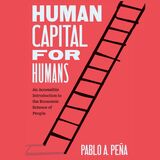 Human Capital for Humans: An Accessible Introduction to the Economic Science of People
Pablo A. Peña
University of Chicago Press, 2025 This is an auto-narrated audiobook version of this book.
An everyday introduction to the most consequential science of modern life.
University of Chicago economist Gary Becker won the Nobel Prize largely for his advancement of human capital theory—the idea that investing in a person’s knowledge and skills has a wide range of economic effects. Becker’s writing on the subject was technical, but his teaching, especially in his famous doctoral course at Chicago, remains legendary for its accessibility, brilliance, and applications to everyday life.
In Human Capital for Humans, economist and former Becker student Pablo A. Peña channels this classroom approach to produce an accessible, essential guide to understanding the science that has become synonymous with modern life and the economy. With an illustrative and immersive style, Peña unpacks the human capital approach to domains such as parenting, aging, marriage, health, and household labor. The result is not only intellectually elevated, but an essential introduction for learners and teachers of this subject across business, management, economics, policy, and beyond.
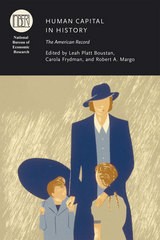 Human Capital in History: The American Record
Edited by Leah Platt Boustan, Carola Frydman, and Robert A. Margo
University of Chicago Press, 2014 America’s expansion to one of the richest nations in the world was partly due to a steady increase in labor productivity, which in turn depends upon the invention and deployment of new technologies and on investments in both human and physical capital. The accumulation of human capital—the knowledge and skill of workers—has featured prominently in American economic leadership over the past two centuries.
Human Capital in History brings together contributions from leading researchers in economic history, labor economics, the economics of education, and related fields. Building on Claudia Goldin’s landmark research on the labor history of the United States, the authors consider the roles of education and technology in contributing to American economic growth and well-being, the experience of women in the workforce, and how trends in marriage and family affected broader economic outcomes. The volume provides important new insights on the forces that affect the accumulation of human capital.
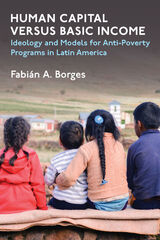 Human Capital versus Basic Income: Ideology and Models for Anti-Poverty Programs in Latin America
Fabián A. Borges
University of Michigan Press, 2022 Latin America underwent two major transformations during the 2000s: the widespread election of left-leaning presidents (the so-called left turn) and the diffusion of conditional cash transfer programs (CCTs)—innovative social programs that award regular stipends to poor families on the condition that their children attend school. Combining cross-national quantitative research covering the entire region and in-depth case studies based on field research, Human Capital versus Basic Income: Ideology and Models for Anti-Poverty Programs in Latin America challenges the conventional wisdom that these two transformations were unrelated. In this book, author Fabián A. Borges demonstrates that this ideology greatly influenced both the adoption and design of CCTs.
There were two distinct models of CCTs: a “human capital” model based on means-tested targeting and strict enforcement of program conditions, exemplified by the program launched by Mexico’s right, and a more universalistic “basic income” model with more permissive enforcement of conditionality, exemplified by Brazil’s program under Lula. These two models then spread across the region. Whereas right and center governments, with assistance from international financial institutions, enacted CCTs based on the human capital model, the left, with assistance from Brazil, enacted CCTs based on the basic income model.
The existence of two distinct types of CCTs and their relation to ideology is supported by quantitative analyses covering the entire region and in-depth case studies based on field research in three countries. Left-wing governments operate CCTs that cover more people and spend more on those programs than their center or right-wing counterparts. Beyond coverage, a subsequent analysis of the 10 national programs adopted after Lula’s embrace of CCTs confirms that program design—evaluated in terms of scope of the target population, strictness of conditionality enforcement, and stipend structure—is shaped by government ideology. This finding is then fleshed out through case studies of the political processes that culminated in the adoption of basic income CCTs by left-wing governments in Argentina and Bolivia and a human capital CCT by a centrist president in Costa Rica.
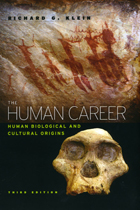 The Human Career: Human Biological and Cultural Origins, Third Edition
Richard G. Klein
University of Chicago Press, 2009 Since its publication in 1989, The Human Career has proved to be an indispensable tool in teaching human origins. This substantially revised third edition retains Richard G. Klein’s innovative approach while showing how cumulative discoveries and analyses over the past ten years have significantly refined our knowledge of human evolution. Klein chronicles the evolution of people from the earliest primates through the emergence of fully modern humans within the past 200,000 years. His comprehensive treatment stresses recent advances in knowledge, including, for example, ever more abundant evidence that fully modern humans originated in Africa and spread from there, replacing the Neanderthals in Europe and equally archaic people in Asia. With its coverage of both the fossil record and the archaeological record over the 2.5 million years for which both are available, The Human Career demonstrates that human morphology and behavior evolved together. Throughout the book, Klein presents evidence for alternative points of view, but does not hesitate to make his own position clear. In addition to outlining the broad pattern of human evolution, The Human Career details the kinds of data that support it. For the third edition, Klein has added numerous tables and a fresh citation system designed to enhance readability, especially for students. He has also included more than fifty new illustrations to help lay readers grasp the fossils, artifacts, and other discoveries on which specialists rely. With abundant references and hundreds of images, charts, and diagrams, this new edition is unparalleled in its usefulness for teaching human evolution.
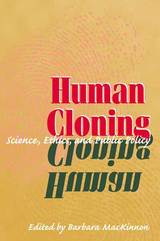 Human Cloning: Science, Ethics, and Public Policy
Edited by Barbara MacKinnon
University of Illinois Press, 2000 Is human cloning a science fiction nightmare come true? Or is it a practical avenue toward beneficial new medical treatments and techniques?
In this concise volume, experts on all sides of the debate make arguments for why we should either pursue, regulate, or ban the cloning of human beings. From this collection, readers will gain a clearer picture of the history of cloning in agriculture and animal science, the various biological procedures that are encompassed by the term "cloning," the philosophical arguments in support of and opposed to cloning humans, and the considerations that should inform discussions about public policy matters related both the cloning research and to human cloning itself.
Balancing scientific detail with philosophical argument, Human Cloning succinctly outlines what cloning is and is not (e.g., cloning does not produce identical individuals), what has led to recent scientific developments, what is now possible, and what ethical dilemmas cloning presents. Opponents claim that cloning subverts human dignity, makes a mockery of spousal love, and poses serious safety hazards. Proponents cite a range of potential benefits, such as producing transplant tissue that is less likely to be rejected, extending current techniques of artificial insemination, and controlling genetic abnormalities to prevent birth defects.
Cloning itself is not new, but as the science of cloning continues to advance--and as human cloning thus inches closer to reality--we are compelled to consider its implications for society. Human Cloning is a lucid, substantive guide to this contentious and potentially revolutionary issue.
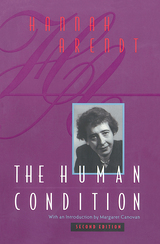 The Human Condition: Second Edition
Hannah Arendt
University of Chicago Press, 1998 A work of striking originality bursting with unexpected insights, The Human Condition is in many respects more relevant now than when it first appeared in 1958. In her study of the state of modern humanity, Hannah Arendt considers humankind from the perspective of the actions of which it is capable. The problems Arendt identified then—diminishing human agency and political freedom, the paradox that as human powers increase through technological and humanistic inquiry, we are less equipped to control the consequences of our actions—continue to confront us today. This new edition, published to coincide with the fortieth anniversary of its original publication, contains an improved and expanded index and a new introduction by noted Arendt scholar Margaret Canovan which incisively analyzes the book's argument and examines its present relevance. A classic in political and social theory, The Human Condition is a work that has proved both timeless and perpetually timely.
Hannah Arendt (1906-1975) was one of the leading social theorists in the United States. Her Lectures on Kant's Political Philosophy and Love and Saint Augustine are also published by the University of Chicago Press.
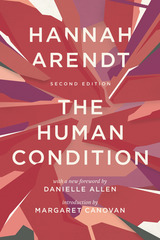 The Human Condition: Second Edition
Hannah Arendt
University of Chicago Press, 2018 A classic work of political thought, more relevant today than ever
The twenty-first century has seen a resurgence of interest in the political thinker Hannah Arendt, “the theorist of beginnings,” whose work probes the logics underlying unexpected transformations—from totalitarianism to revolution.
A work of striking originality, The Human Condition is in many respects more relevant now than when it first appeared in 1958. In her study of the state of modern humanity, Hannah Arendt considers humankind from the perspective of the actions of which it is capable. The problems Arendt identified then—diminishing human agency and political freedom, the paradox that as human powers increase through technological and humanistic inquiry, we are less equipped to control the consequences of our actions—continue to confront us today. This new edition, published to coincide with the sixtieth anniversary of its original publication, contains Margaret Canovan’s 1998 introduction and a new foreword by Danielle Allen.
A classic in political and social theory, The Human Condition is a work that has proved both timeless and perpetually timely.
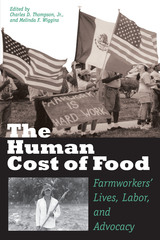 The Human Cost of Food: Farmworkers' Lives, Labor, and Advocacy
Edited by Charles D. Thompson, Jr., and Melinda F. Wiggins
University of Texas Press, 2002 Finding fresh fruits and vegetables is as easy as going to the grocery store for most Americans—which makes it all too easy to forget that our food is cultivated, harvested, and packaged by farmworkers who labor for less pay, fewer benefits, and under more dangerous conditions than workers in almost any other sector of the U.S. economy. Seeking to end the public's ignorance and improve workers' living and working conditions, this book addresses the major factors that affect farmworkers' lives while offering practical strategies for action on farmworker issues. The contributors to this book are all farmworker advocates—student and community activists and farmworkers themselves. Focusing on workers in the Southeast United States, a previously understudied region, they cover a range of issues, from labor organizing, to the rise of agribusiness, to current health, educational, and legal challenges faced by farmworkers. The authors blend coverage of each issue with practical suggestions for working with farmworkers and other advocates to achieve justice in our food system both regionally and nationally.
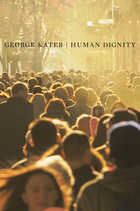 Human Dignity
George Kateb
Harvard University Press, 2014 We often speak of the dignity owed to a person. And dignity is a word that regularly appears in political speeches. Charters are promulgated in its name, and appeals to it are made when people all over the world struggle to achieve their rights. But what exactly is dignity? When one person physically assaults another, we feel the wrong demands immediate condemnation and legal sanction. Whereas when one person humiliates or thoughtlessly makes use of another, we recognize the wrong and hope for a remedy, but the social response is less clear. The injury itself may be hard to quantify.
Given our concern with human dignity, it is odd that it has received comparatively little scrutiny. Here, George Kateb asks what human dignity is and why it matters for the claim to rights. He proposes that dignity is an “existential” value that pertains to the identity of a person as a human being. To injure or even to try to efface someone’s dignity is to treat that person as not human or less than human—as a thing or instrument or subhuman creature. Kateb does not limit the notion of dignity to individuals but extends it to the human species. The dignity of the human species rests on our uniqueness among all other species. In the book’s concluding section, he argues that despite the ravages we have inflicted on it, nature would be worse off without humanity. The supremely fitting task of humanity can be seen as a “stewardship” of nature. This secular defense of human dignity—the first book-length attempt of its kind—crowns the career of a distinguished political thinker.
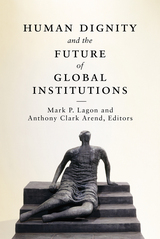 Human Dignity and the Future of Global Institutions
Mark P. Lagon and Anthony Clark Arend, Editors
Georgetown University Press, 2014 What does human dignity mean and what role should it play in guiding the mission of international institutions? In recent decades, global institutions have proliferated—from intergovernmental organizations to hybrid partnerships. The specific missions of these institutions are varied, but is there a common animating principle to inform their goals? Presented as an integrated, thematic analysis that transcends individual contributions, Human Dignity and the Future of Global Institutions argues that the concept of human dignity can serve as this principle. Human dignity consists of the agency of individuals to apply their gifts to thrive, and requires social recognition of each person's inherent value and claim to equal access to opportunity. Contributors examine how traditional and emerging institutions are already advancing human dignity, and then identify strategies to make human dignity more central to the work of global institutions. They explore traditional state-created entities, as well as emergent, hybrid institutions and faith-based organizations. Concluding with a final section that lays out a path for a cross-cultural dialogue on human dignity, the book offers a framework to successfully achieve the transformation of global politics into service of the individual.
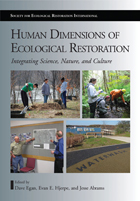 Human Dimensions of Ecological Restoration: Integrating Science, Nature, and Culture
Edited by Dave Egan, Evan E. Hjerpe, and Jesse Abrams
Island Press, 2011 When it comes to implementing successful ecological restoration projects, the social, political, economic, and cultural dimensions are often as important as-and sometimes more important than-technical or biophysical knowledge. Human Dimensions of Ecological Restoration takes an interdisciplinary look at the myriad human aspects of ecological restoration. In twenty-six chapters written by experts from around the world, it provides practical and theoretical information, analysis, models, and guidelines for optimizing human involvement in restoration projects. Six categories of social activities are examined: - collaboration between land manager and stakeholders
- ecological economics
- volunteerism and community-based restoration
- environmental education
- ecocultural and artistic practices
- policy and politics
For each category, the book offers an introductory theoretical chapter followed by multiple case studies, each of which focuses on a particular aspect of the category and provides a perspective from within a unique social/political/cultural setting. Human Dimensions of Ecological Restoration delves into the often-neglected aspects of ecological restoration that ultimately make the difference between projects that are successfully executed and maintained with the support of informed, engaged citizens, and those that are unable to advance past the conceptual stage due to misunderstandings or apathy. The lessons contained will be valuable to restoration veterans and greenhorns alike, scholars and students in a range of fields, and individuals who care about restoring their local lands and waters.
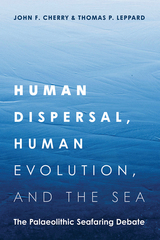 Human Dispersal, Human Evolution, and the Sea: The Palaeolithic Seafaring Debate
John F. Cherry
University Press of Colorado, 2025 Human Dispersal, Human Evolution, and the Sea is the first book-length treatment of what has become known as the global Palaeolithic seafaring debate. Until recently, common consensus dictated that only in the last ten thousand years have humans routinely, permanently, and cross-culturally traversed seas and oceans to colonize new lands. New (and sometimes contentious) data from the Mediterranean and Island Southeast Asia challenge that consensus, suggesting to some researchers that long-distance voyaging is a behavior of great antiquity. These scholars suggest that oceans and seas facilitated and encouraged planetary dispersal in our own genus rather than acting as barriers to dispersal. If this model is correct, it necessitates a radical rethinking of not only the big patterns of human history but also more deeply our models of emergent human behavior and when the capacity for highly complex and coordinated group behaviors emerged.
Exploring the data in detail, the authors here show how a complex series of interrelated problems has tended to be treated in reductionist or overly simplistic terms. Cherry and Leppard elucidate this complexity by bringing to bear perspectives from archaeology, ecology, and evolutionary biology. They demonstrate not only that a series of unique circumstances—evolutionary, behavioral, environmental, and economic—conspired to drive mass, ubiquitous global colonization over the last ten millennia; but also that earlier, sparser data provide real insight into key social and behavioral thresholds, even if there is little evidence to support the “oceans as highways” model for species other than our own.
A major intervention in this important debate, Human Dispersal, Human Evolution, and the Sea explains the deep significance of the problem and the profound implications for history, archaeology, and biological anthropology.
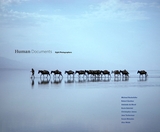 Human Documents: Eight Photographers
Conceived by Robert Gardner and Edited by Charles WarrenPhotographs by Michael Rockefeller, Robert Gardner, Kevin Bubriski, Adelaide de Menil, Christopher James, Jane Tuckerman, Susan Meiselas, and Alex Webb
Harvard University Press, 2009 In Human Documents, Robert Gardner introduces the work of photographers with whom he has worked over a period of nearly fifty years under the auspices of the Film Study Center at Harvard. Their images achieve the status of what Gardner calls “human documents”: visual evidence that testifies to our shared humanity. In images and words, the book adds to the already significant literature on photography and filmmaking as ways to gather both fact and insight into the human condition. In nearly 100 images spanning geographies and cultures including India, New Guinea, Ethiopia, and the United States, Human Documents demonstrates the important role photography can play in furthering our understanding of human nature and connecting people through an almost universal visual language.
Author and cultural critic Eliot Weinberger contributes the essay “Photography and Anthropology (A Contact Sheet),” in which he provides a new and intriguing context for viewing and thinking about the images presented here.
With photographs by Michael Rockefeller, Robert Gardner, Kevin Bubriski, Adelaide de Menil, Christopher James, Jane Tuckerman, Susan Meiselas, and Alex Webb.
 The Human Drama of Abortion: A Global Search for Consensus
Anibal Faundes
Vanderbilt University Press, 2006 Abortion 101, an accessible account of abortion practices and ethical issues around the globe, for students, activists, and policymakers
Deeply touched by the tragedies of botched abortions that they witnessed as medical students and young physicians in Chile in the 1940s and later around the world, the authors have attempted in their professional lives and now in this book to establish a framework for dialogue to replace the polarization that exists today.
Doctors Faundes and Barzelatto use their decades of international work to document the personal experiences of different classes of women in different countries and those countries' policies and practices. No other book provides such a comprehensive and reasoned examination of the entire topic of abortion, from the medical to the religious and ethical and from the psychological to the legal, in plain language understandable by non-specialists.
The central thesis is that there are too many induced abortions in the world today, that most are preventable and should be prevented--a middle ground that both pro-life and pro-choice advocates can accept. The first part of the book reviews why women have abortions, as well as the magnitude and consequences. The second part examines values. The third part discusses effective interventions. The final part states conclusions about what can be done to reach a necessary social consensus.
The Portuguese edition of this book was issued at the very end of 2004. The Spanish edition, launched in mid-2005, is already in a second printing. The authors are making presentations at special events sponsored by universities, professional associations, and feminist networks in Argentina, Chile, Mexico, Peru, Uruguay, Colombia, the Dominican Republic, and the United States.
|
|

